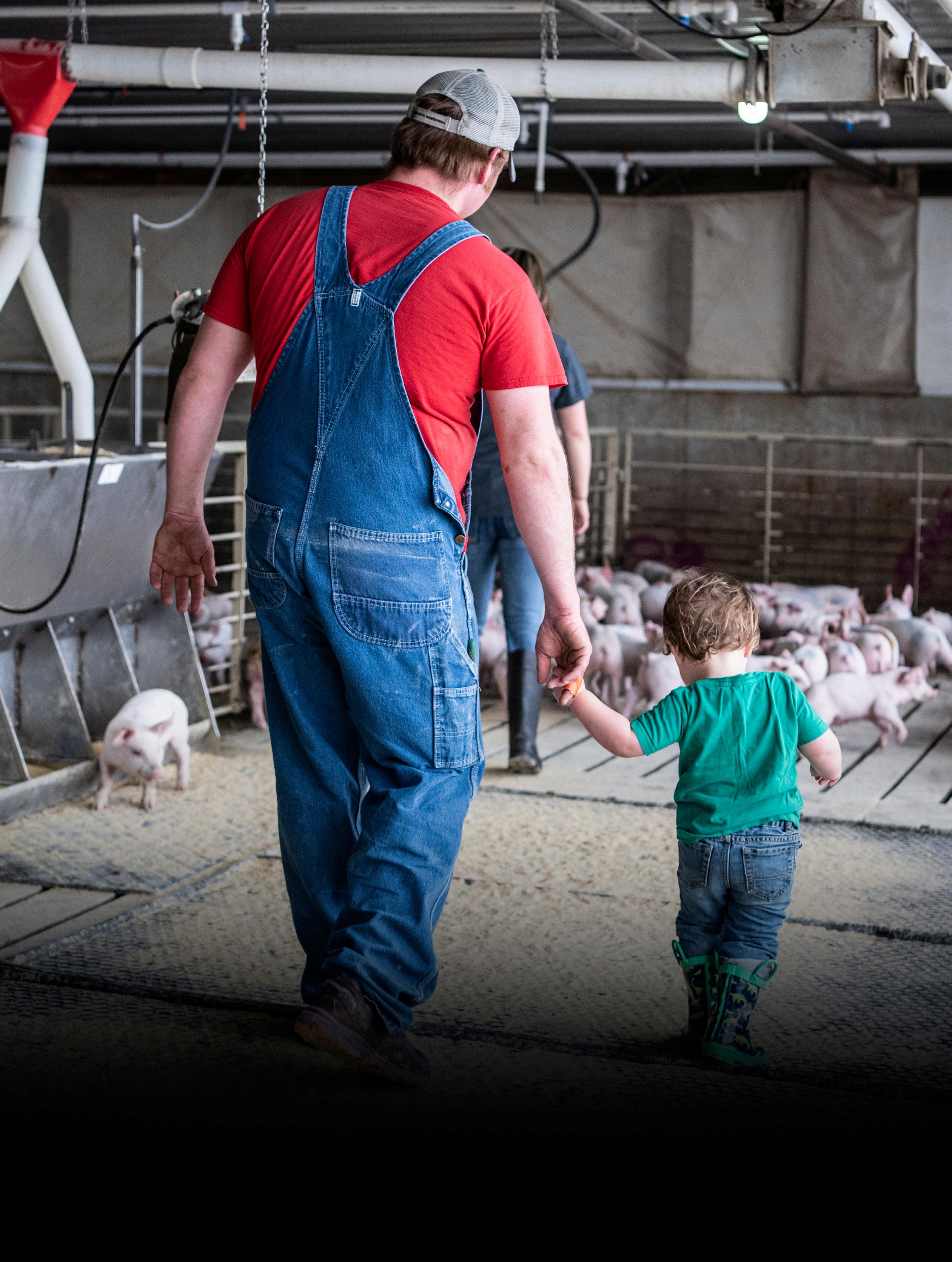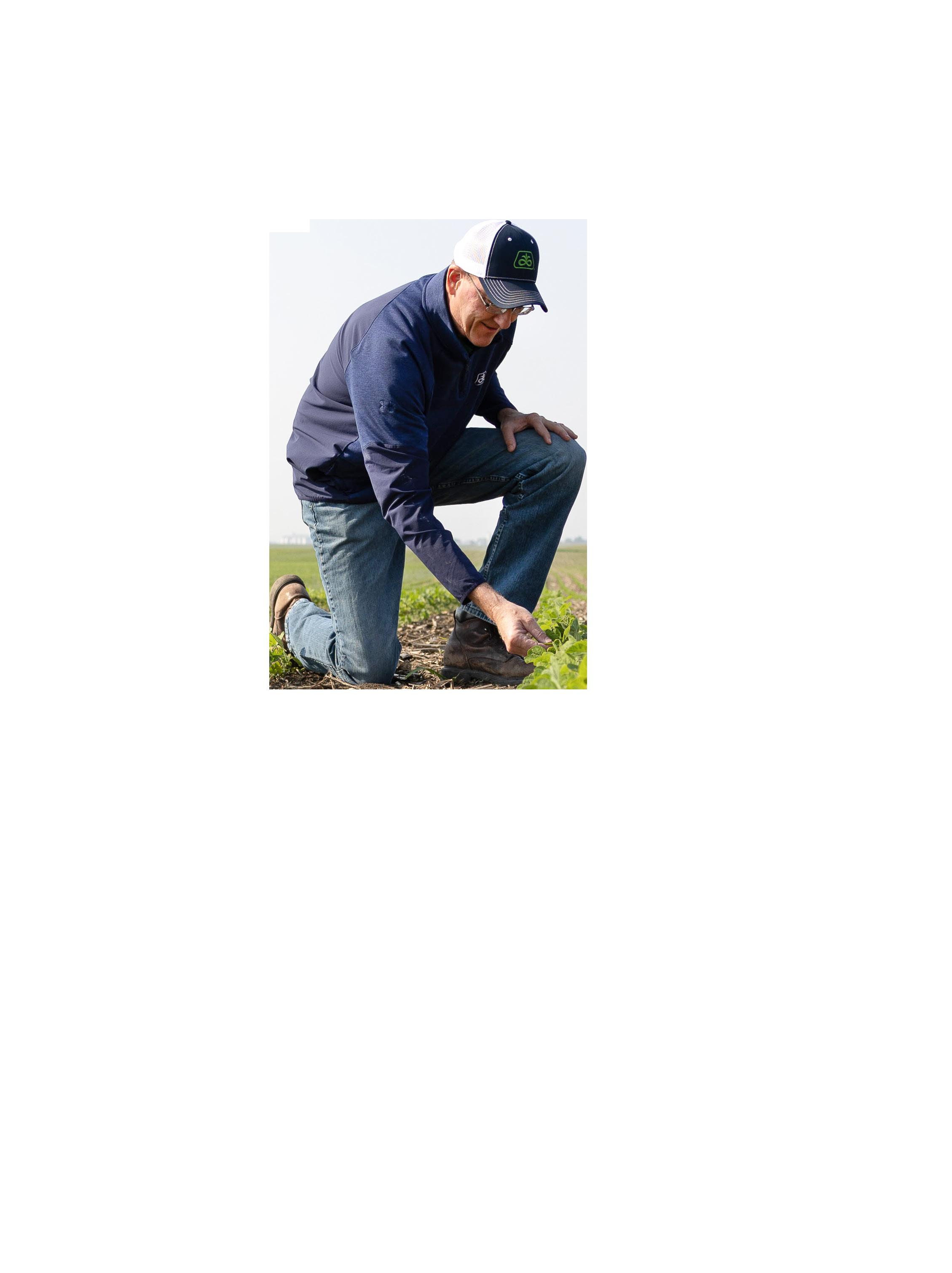

What’s Next in Soybean Seed Development Built for the Field:
We put soybeans first because you put performance first.
At Asgrow® brand, not only are we all about the beans, we’re all about your success as well. That’s why we o er localized products with leading genetics, weed management systems and maximum pro t potential – all developed by soybean experts who put soybeans rst.
DISCOVER HOW IT’S ALL ABOUT THE BEANS. Asgrow.com
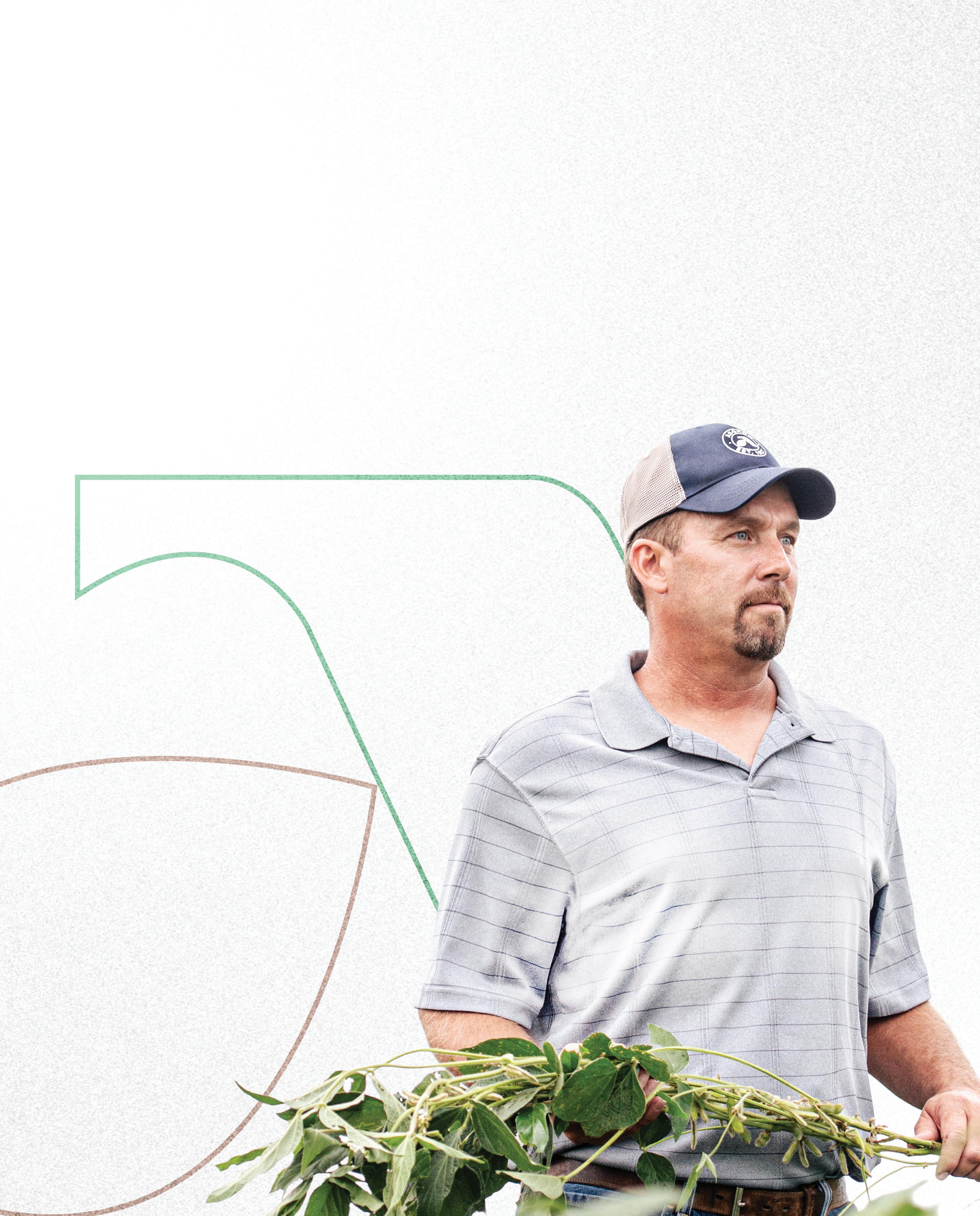


Executive Committee
President
Brent Swart, Spencer | D1
President-elect
Tom Adam, Harper | D9
Secretary
Sam Showalter, Hampton | D2
Treasurer
Lee Brooke, Clarinda | D7
At-Large Director
Scot Bailey, Anita | D7
Board of Directors
Paul Kassel, Spencer | D1
Brent Renner, Klemme | D2
Mike Yegge, Lake Mills | D2
Rick Juchems, Plainfield | D3
Amanda Tupper, Ionia | D3
Marty Danzer, Carroll | D4
Jeff Frank, Lake View | D4
Corey Goodhue, Carlisle | D5
Dave Struthers, Collins | D5
Matt Willimack, DeWitt | D6
Dave Walton, Wilton | D6
Warren Bachman, Osceola | D8
Randy Miller, Lacona | D8
Jeff Ellis, Donnellson | D9
Jack Boyer, Reinbeck | At-Large
Aimee Bissell, Bedford | At-Large
Sharon Chism, Huxley | At-Large
American Soybean Association Board of Directors
Tom Adam, Harper
Steph Essick, Dickens
Morey Hill, Madrid
Randy Miller, Lacona
Dave Walton, Wilton
United Soybean Board of Directors
Tim Bardole, Rippey
Robb Ewoldt, Davenport
Brent Renner, Klemme
Suzanne Shirbroun, Farmersburg Staff Credits
Bethany Baratta | Editor
Aaron Putze, APR | CO Brand Mgmt and Engagement
Susan Langman | Creative Design Coordinator
Joclyn Kuboushek | Multimedia Specialist
Kriss Nelson | Senior Writer
Brock Johnston | Public Relations Manager
FARMER FOCUSED | DRIVEN TO DELIVER
ISA VISION
We advance the long-term competitiveness of Iowa soybean farmers.
ISA MISSION
Driven to deliver opportunities for Iowa soybean farmers to thrive.
Iowa Soybean Review is published monthly by:
Iowa Soybean Association 1255 SW Prairie Trail Parkway, Ankeny, Iowa 50023 (515) 251-8640 | iasoybeans.com
E-mail: bbaratta@iasoybeans.com
For advertising information contact Bethany Baratta at (515) 334-1020 or bbaratta@iasoybeans.com
August 2025 | Vol. 38, No. 11
4 Protecting Soybean Oil
Countering misinformation and protecting market demand.
12
Five Steps to Seed Selection
Before making seed selection decisions, consider these tips.
19
Iowa Soybean Association Launches Partners+ Program
Exclusive discounts now available to ISA members.
24
B99 Hits the Road
Cleaner fuel option expands market for soybeans.
On the Cover: While the 2025 crop is still growing, farmers are thinking about next year’s crop and seed selection. Alex Woodall, an Iowa Soybean Association farmer member near Kamrar, says future seed innovation must consider yield, traits and whatever Mother Nature throws out during the growing season. In this issue, we asked farmers and others to consider what future seed traits they’d like to grow in their fields.
Photo by Joclyn Kuboushek.
Comments and statewide news articles should be sent to the above address. Advertising space reservations must be made two months preceding publication. In consideration of the acceptance of the advertisement, the agency and the advertiser must, in respect of the contents of the advertisement, indemnify and save the publisher harmless against any expense arising from claims or actions against the publisher because of the publication of the content of the advertisement.


Executive Insights
Kirk
Leeds,
ISA
Chief Executive Officer kleeds@iasoybeans.com
Protecting Soybean Oil: Addressing Misinformation and Safeguarding Demand
Soybean oil is a cornerstone of the U.S. agricultural economy and a vital ingredient in the diets of millions. As soybean farmers, you know the importance of this versatile product. Soybean oil used for food accounts for 61% of soybean oil used in the United States. Misinformation campaigns targeting seed oils, including soybean oil, threaten to undermine its reputation, demand and future. They also risk regulatory actions that could disrupt markets and increase costs for producers and consumers.
This issue strikes close to home. I’m the son of a grocery store owner. Consumer trust in the food business is vital. False claims made against soybean oil are not credible, and needlessly concern and confuse consumers. Decades of research, led by the U.S. Food and Drug Administration, highlight the benefits of soybean oil in reducing the risk of coronary heart disease and supporting overall health. Soybean oil’s heart-healthy
profile makes it a valuable part of a balanced diet.
The push for regulatory action against seed oils would be yet another economic headwind facing consumers. The World Agricultural Economic and Environmental Services says replacing seed oils in the U.S. food supply would result in a 43% increase in consumer costs for edible fats and oils, largely due to reliance on imported alternatives like palm oil. The Soy Nutrition Institute (SNI) Global, American Soybean Association (ASA), and United Soybean Board (USB) are countering these false claims to protect soybean oil’s reputation.
In May, ASA and other groups held a congressional fly-in organized by the Seed Oil Organizing Group. They engaged lawmakers and their staff about the nutritional benefits of seed oils and the economic risks of disrupting access. SNI Global published fact sheets that debunk anti-seed oil claims with evidence-based research.
USB has posted timely content that also counters misinformation on its website (USSoy.org).
But the most effective way to make the case for seed oils is for farm families to talk about this important market driver. The edible oils market is a catalyst for domestic demand, and protecting soybean oil from misinformation is essential to maintaining this market.
Stay informed and join in the conversation (this issue is another reason to participate in ISA’s Communications Squad to make time to improve your communications confidence and skills). Don’t shy away from the conversation. Share accurate information and amplify the efforts of ISA, ASA, USB and our many allied partners, whether by word of mouth, a letter to your congressional representative or via social media. Your voice matters in this discussion. Thanks for doing your part. Stay safe on the farm and hope to see you at the Iowa State Fair!




























Get the rates, terms and flexibility you need to finance the land you want.
When there’s a piece of land you want to buy, we offer a variety of rate options, including long-term fixed rates and payment flexibility. Cash-back dividends offer a significant benefit, too. Learn more about our ag-friendly financing by calling 800-884-FARM. Agriculture Works Here.® FCSAmerica.com

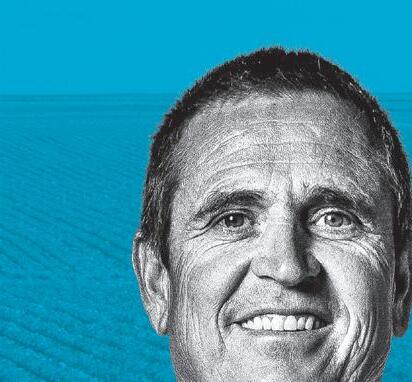


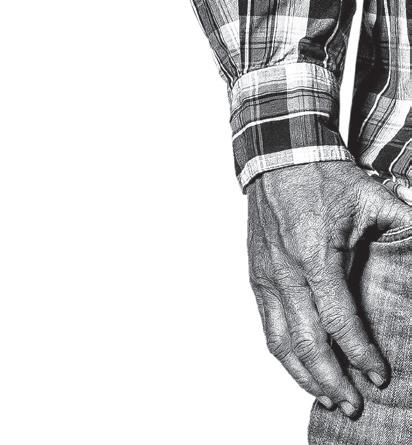







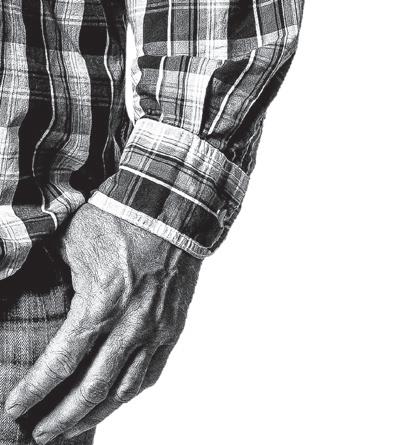
for over 40 years, your cooperative soybean processor
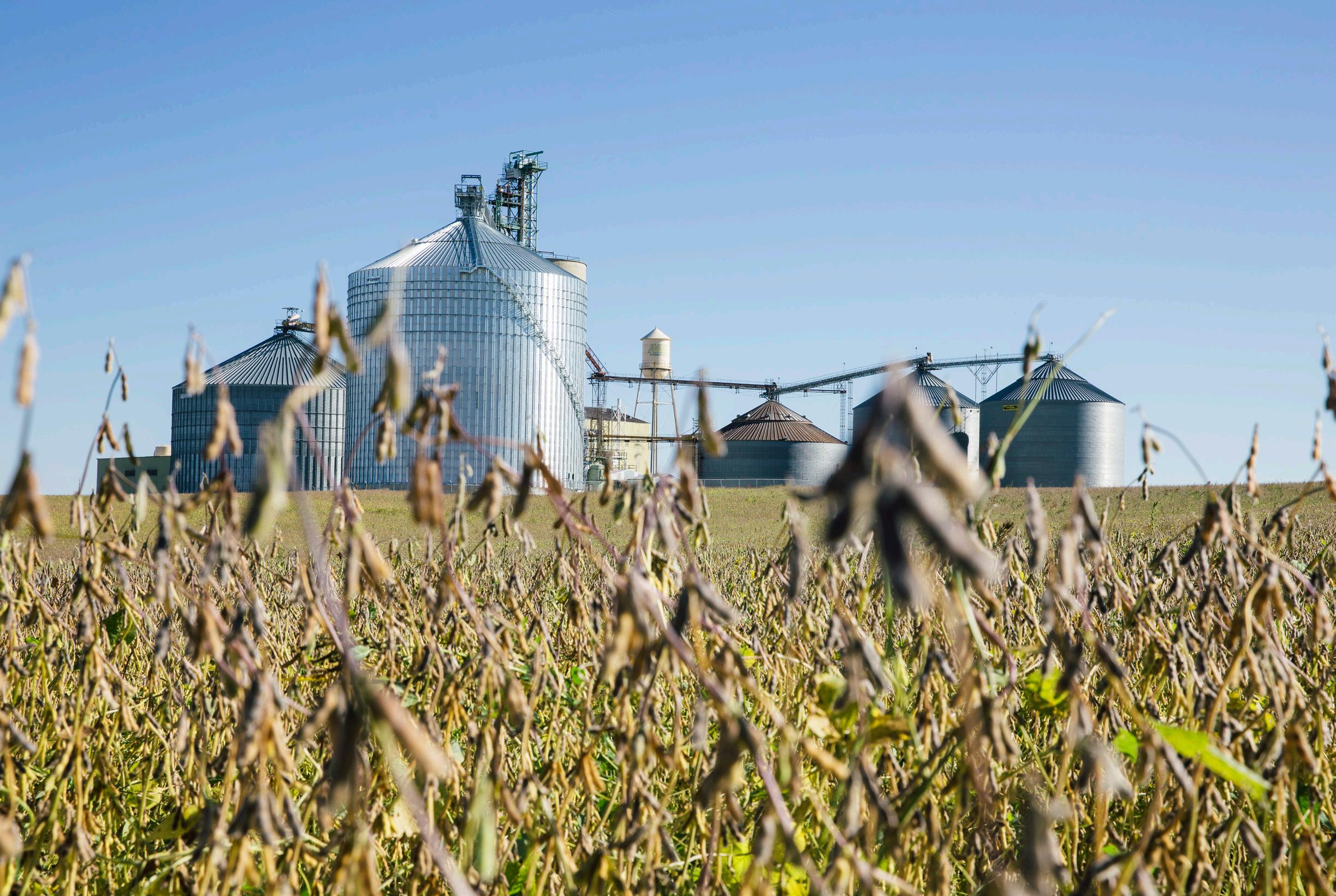

LEAD THE FIELD.
The new Brandt DXT dual-auger grain cart delivers the capacity and speed to meet the demands of your fast-paced harvest season.
More Efficient
The high-slope tank and high-capacity auger deliver unload speeds of 1,000 bushels per minute.
More Versatile
Choose from five model sizes, 22" or 24" auger, and right or left side unload to fit your operation.
More Reliable
High-quality components and low maintenance requirements ensure maximum uptime.
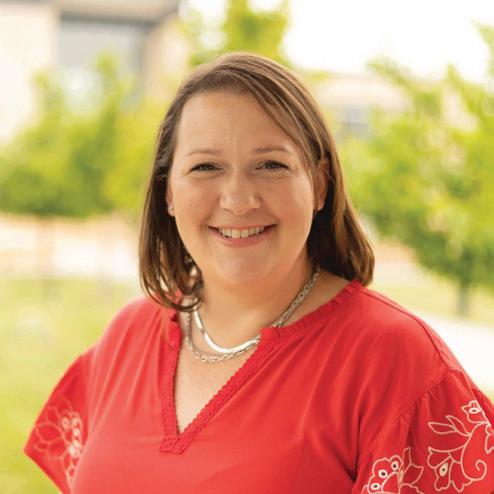
Celebrating Soy
It’s a big month. With Left-Handers Day, Dog Appreciation Day, the Iowa Soybean Association’s Summer Soy Series, World Photo Day, the Iowa State Fair, and back-to-school chaos, August is anything but lazy.
Amid all the energy and events, one celebration in particular stands out for its deep roots in Iowa.
August is also Soybean Month in Iowa.
Rural Route 2
Editor’s Note by Bethany Baratta bbaratta@iasoybeans.com
It’s easy to celebrate a crop that has so many applications to everyday life. From candles to cleansers and fuel to flour, soybeans provide the food, fiber and feed that allows humans, pets and livestock to thrive.
It’s easy to celebrate the Iowa farmers who work year-round to plan, plant and produce the legume; you grew 598 million bushels of soybeans in 2024, nearly 14% of the total U.S. soybean production.
In this issue, Kriss Nelson examines what farmers are looking for in future seed opportunities. We celebrate August Soybean Month in Iowa with some fresh photos by Joclyn Kuboushek. A new Partners Plus Program announced recently provides exclusive benefits to Iowa Soybean Association farmer members. An Insights Report, sent along with this copy of the Review, highlights research results to help you make decisions on your farm. We’re celebrating a significant step forward for B99 in Iowa, a fuel driven by the power of biodiesel.
Not included in this issue are a host of projects, initiatives, meetings and opportunities happening to expand the prospects for the soybean industry.
These efforts include:
• Outreach to lawmakers in Iowa and in Washington, D.C. to ensure decisions there don’t stifle soybean demand and production.
• Engagement in conversations relating to the continuation of programs that help farmers get started in conservation practices.
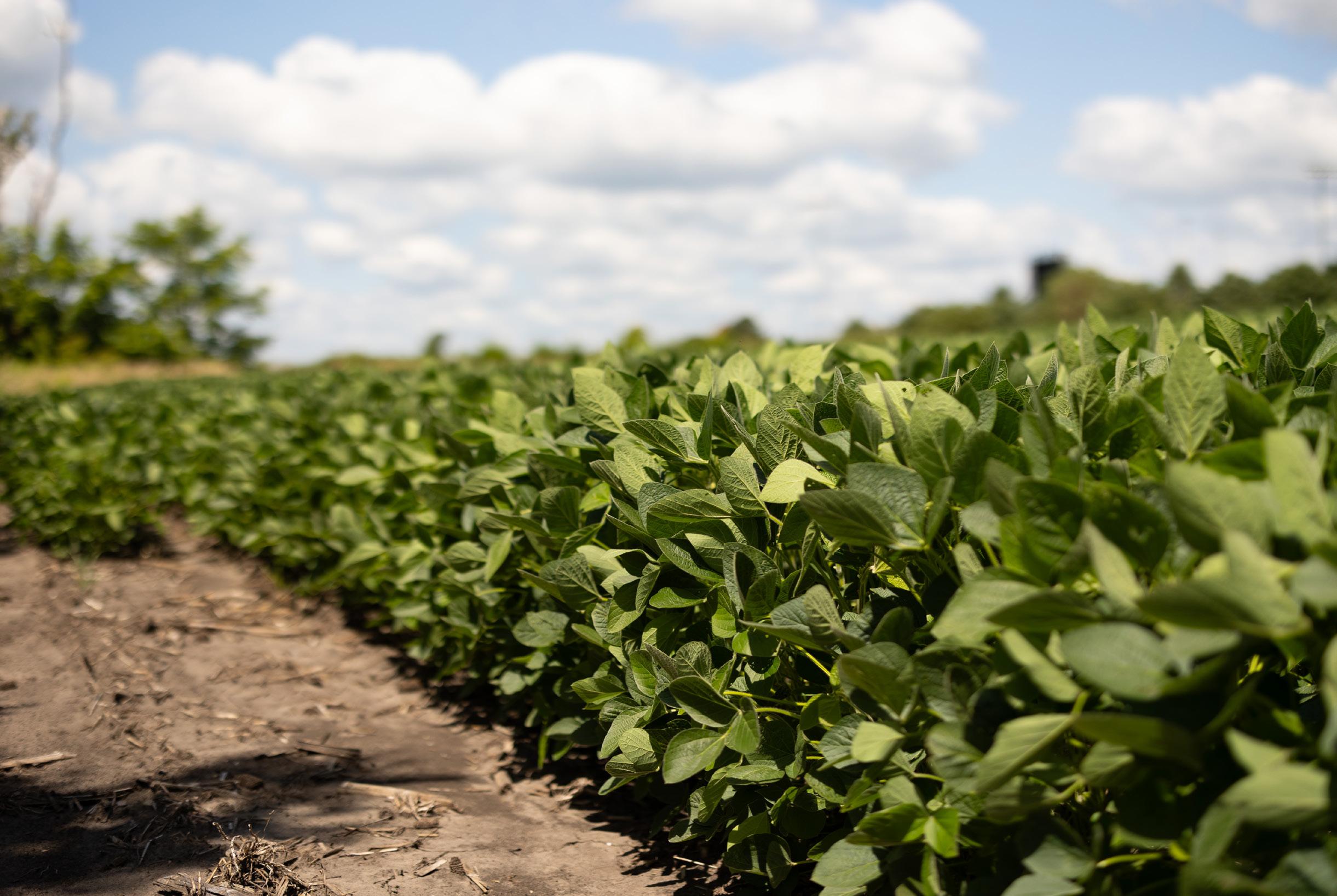
• Reaching consumers to deliver facts regarding seed oils.
• Welcoming new Iowa Soybean Association members to unlock the full benefits of membership (is your membership up to date?).
• Scouting the fields to help farmers understand potential solutions to their acre challenges.
• Facilitating interviews between farmers and media to share the accurate message of what farmers are doing on their farms.
There’s a lot happening behind the scenes to help farmers grow more, earn more and learn more. Like the work you do on your farms yearround, we’re committed to working alongside you (and celebrating soy!) not just during Soybean Month in Iowa, but throughout the year. Take care,

Farmers’ WishList SOYBEAN SEED
Facing weather and weed issues, farmers expect more from soybeans
STORY BY KRISS NELSON | PHOTOGRAPHY BY JOCLYN KUBOUSHEK
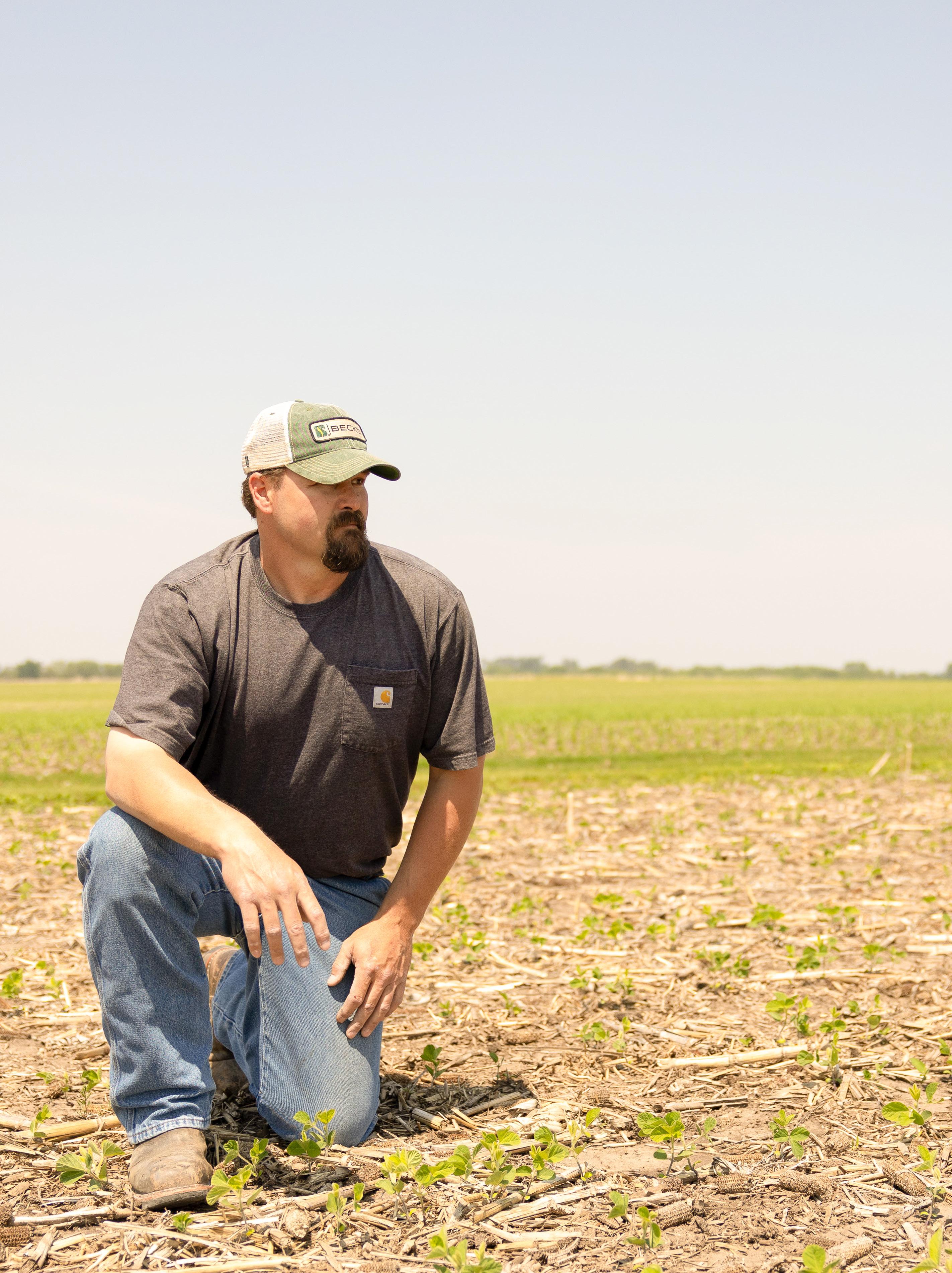
As farming practices evolve, so do the expectations for soybean performance. From battling erratic weather and shifting weed pressures, farmers are looking ahead — and asking more of their soybeans than ever before.
Iowa Soybean Association (ISA) farmer-members and research agronomist share what they would like to see for the future of seed technology.
Dustin Sage on his farm near Dunkerton.
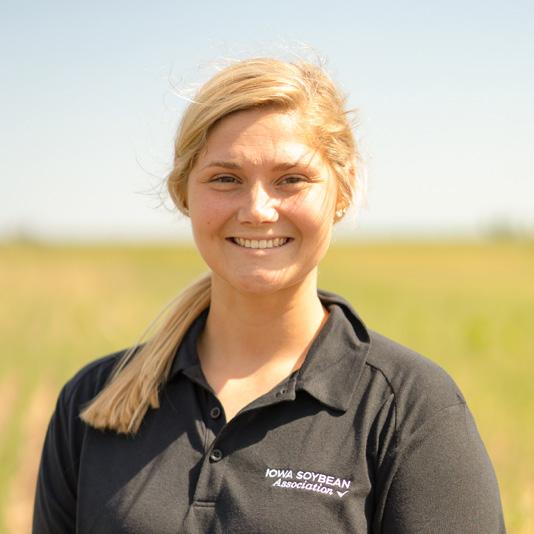
Mikaela Connelly ISA research agronomist
“Examining historical soybean yields reveals that yields have improved significantly over time; however, there is still room for further improvement. As planting dates continue to be pushed earlier, farmers are up against something they can’t control: the weather.
In a cool, wet spring, soybean seedings can be especially susceptible to early-season diseases, such as rhizoctonia, pythium or phytophthora. Therefore, planting resistant varieties and using effective seed treatments are key.
Research and development must continue to produce high-performing varieties and effective seed treatments; therefore, seed companies must invest in developing seed treatments that can make soybeans less susceptible to diseases.
Variety improvement is a key factor in how farmers achieve increased yields. As genetics continue to improve, selecting for plants that can resist diseases might unlock even higher yields.
Get in touch with your ISA research agronomist to investigate new or reoccurring crop challenges.”

“As soybean planting continues to move earlier each season, one of our biggest challenges is getting the seed to emerge strong in cooler, less favorable spring conditions. Seed treatments help, but a built-in trait for early vigor would be even better.
The real key is adapting soybeans to thrive in these earlier planting windows. Pioneer’s research shows we've moved planting up by nearly three weeks — and in my case, it's closer to 30 days. That early start can boost yields, but only if the plant is tough enough to handle the stress. We need varieties that are stronger and more resilient in cold soils to truly win that window.
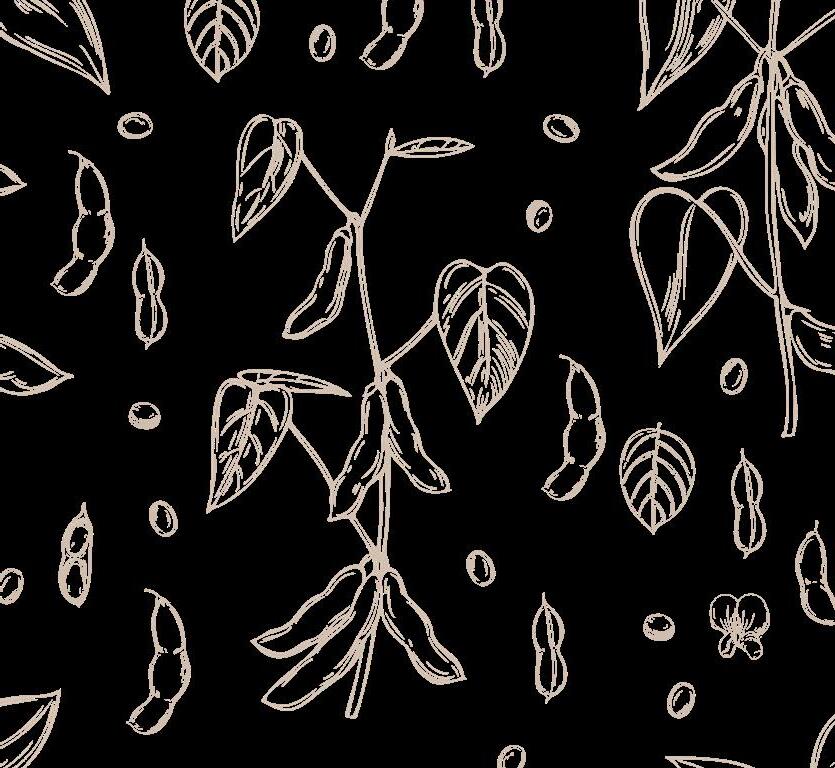
I’d also like to see improvements in seed protection, particularly with insecticide packages, and continued progress in disease resistance. For us farmers in the northeastern part of the state, white mold is still a significant issue. We need soybeans with stronger natural defenses to withstand it.
Another big opportunity lies in trait stacking. Better weed control is always a priority, and if high oleic soybeans, such as Plenish® soybeans are going to be part of our future, they’ll need to include the Enlist® trait so we don’t have to sacrifice weed management for specialty markets.
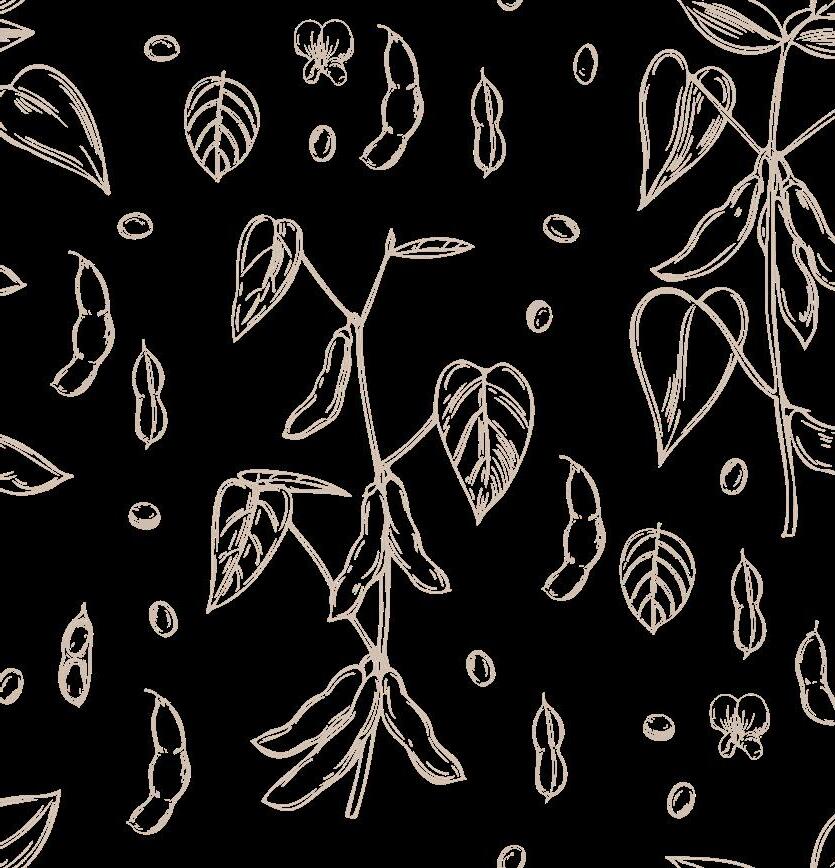
Finally, there's real yield potential if we can help soybeans hold their blossoms longer. I know researchers in the North Central Soybean Research Center are exploring this, and I see it as a key area to boost productivity without adding inputs.”

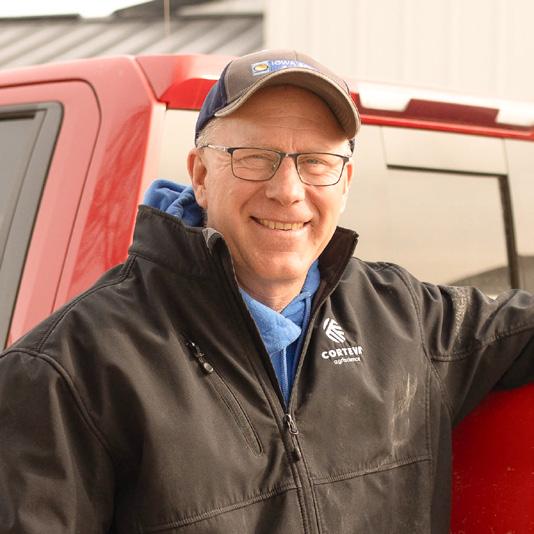
Joe Shirbroun Farmersburg |
District 3

Continued on Pg. 10
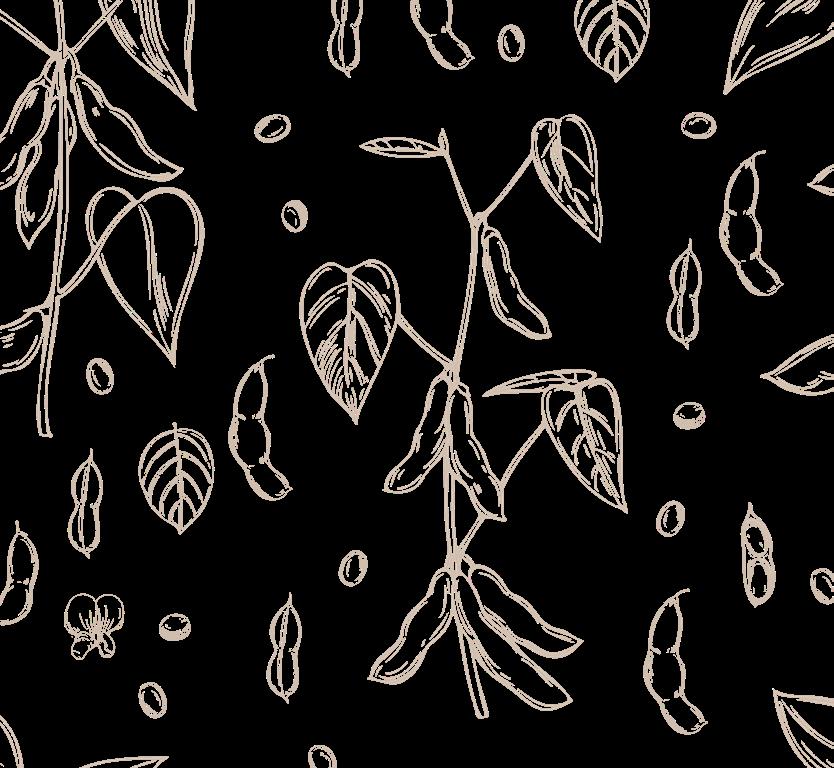
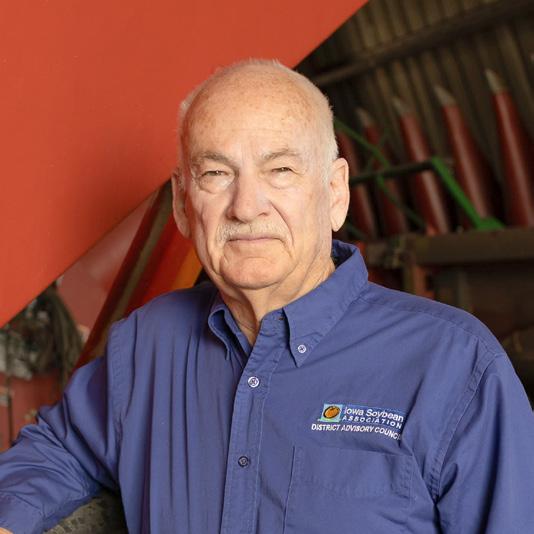
“I’d really like to see more herbicide options — and I’m not talking about recycled corn chemistry slapped onto soybeans. We need new, effective, over-the-top post-emergent products, especially for controlling tough weeds like waterhemp and pigweed. Right now, I’m basically down to just a handful of effective tools, and it’s not enough.
Vigor is another big one. This year was colder and wetter, and I saw emergence issues. Some of that was on me, but a lot of it was just the weather. We need soybeans with better early-season vigor, more like what we see in corn hybrids. That kind of stress tolerance could make a big difference.
Ron Heck Perry | District 5
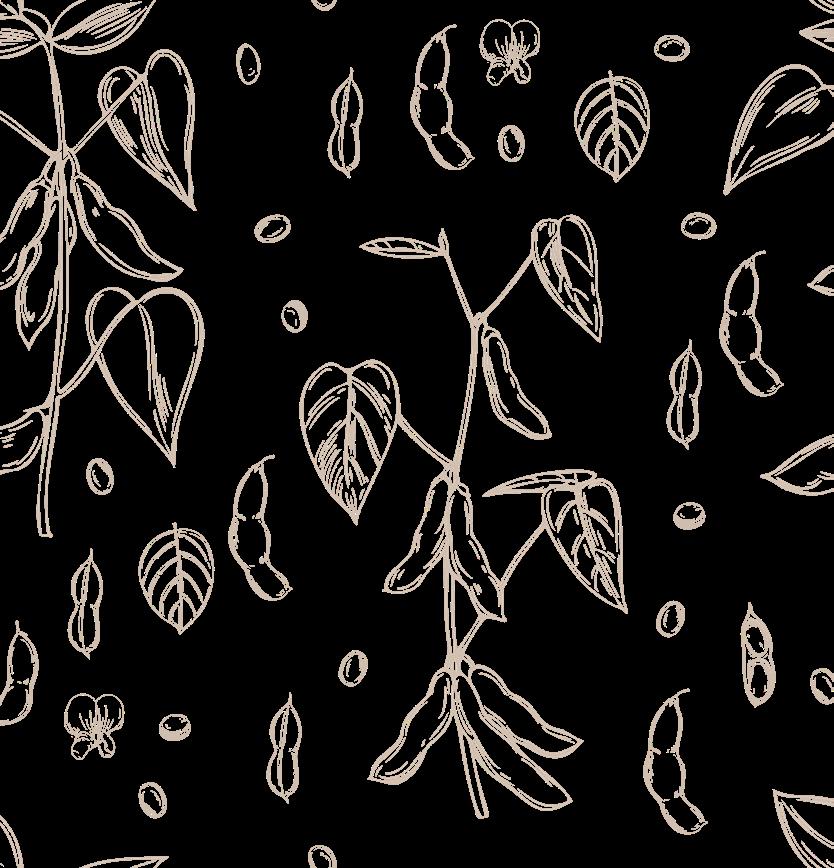
“Farmers are constantly chasing the same three things — more yield, lower input costs and greater consistency. The big question is: how do we get there?
The answer starts with releasing the yield potential that’s already there with better disease and pest resistance. A good defense is important to release the genetic potential we already have.

One of the most immediate impacts we could make is by developing soybeans that grow faster, bushier or taller to shade out herbicide-resistant weeds. The goal is to develop soybeans that are aggressive and healthy, thereby reducing our herbicide bill by suppressing weeds naturally, much like cover crops do, which allows us to lower our herbicide and input costs.
By making soybeans with better defense — not susceptible to pests, diseases and even herbicides — we could take full advantage of the great soils and weather we have. We have black soils here for a reason. Varieties that are bred specifically for us give us a competitive advantage.
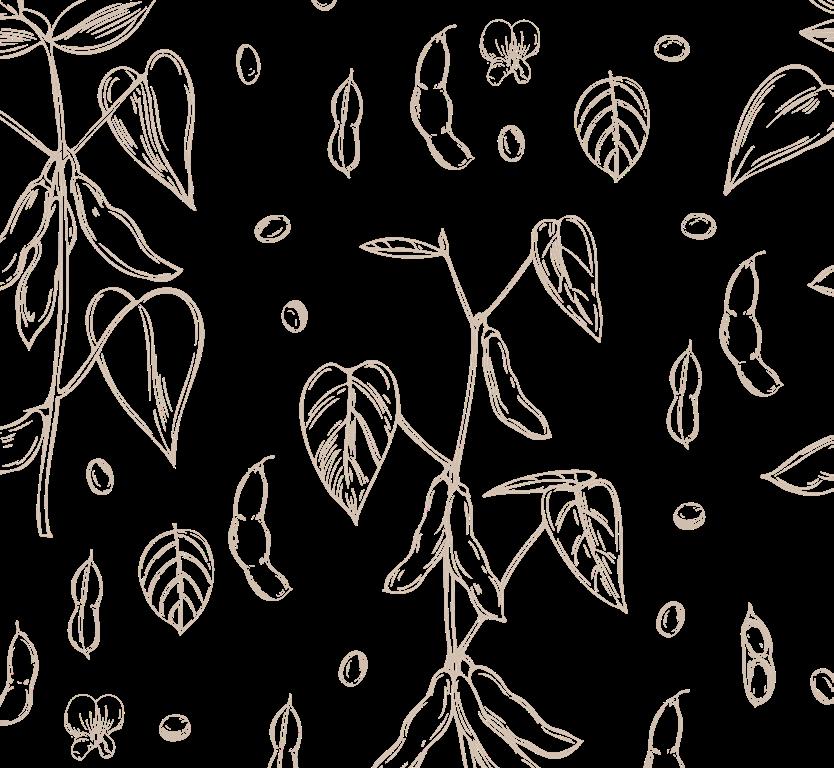
At the end of the day, the goal is the same for all of us: more yield, lower inputs and greater consistency.”

We're on the journey with cover crops and notill practices, and focusing on weed suppression. I'm starting to think I’ll need some soybean varieties that can outcompete certain cover crop species. I know emergence was a challenge this year because of the dry conditions — and there’s only so much you can do about that — but I think there’s room for improvement with agronomic traits that support emergence and possibly even boost yield.
I’d like to see more soybeans with traits that protect against seedling diseases — I’ve dealt with things like Pythium and Phytophthora early in the season, which has forced me to run more defensive varieties. Some good new ones are coming online, and I’ve got a few of them in the ground now that I planted in early April. But after two weeks of rain, we saw some crusting and stress. These are the conditions we’re working in, and we need soybeans that can handle it.
And finally, I feel like my soybean yields have plateaued. I’m doing everything I can to push through it, but it’s not like corn, where we’ve seen more consistent gains. There’s definitely room for improvement on yield potential — and for traits that deliver a real economic return.”
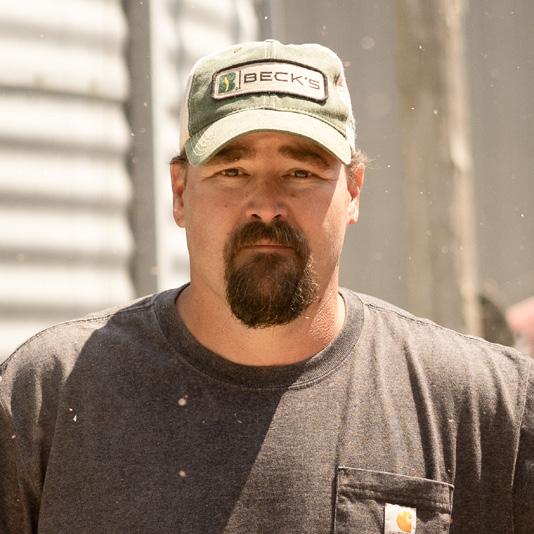
Dustin Sage Dunkerton | District 3

Alex Woodall Pioneer field agronomist Kamrar | District 5
“On the soybean side of things, yield is still king — it's the number one driver of product selection. But beyond yield, farmers are asking for agronomic strength to help manage the realities of their fields.
Here in north-central Iowa, iron deficiency chlorosis (IDC) is a major concern. We need varieties that can tolerate high-pH soils and handle those IDC-prone areas reliably. That trait alone can make or break a variety in this region.
We’re also seeing increased awareness around soybean cyst nematode (SCN). Some farmers have been aggressive about managing it, while others are still catching up. Farmers need more SCNresistant options, not just PI 88788 and Peking, but new sources of resistance.
White mold remains a serious challenge in parts of the state. That’s why protecting soybeans through strong genetic tolerance and field management is so important — it’s a foundational agronomic trait that needs to be part of any highperforming variety.
Another major shift we’ve seen is the earlier planting of soybeans. Over the past five years, the dynamic has completely changed. More growers are planting soybeans ahead of corn. The goal is simple: Extend the vegetative growth window to capture more light before flowering and ultimately drive higher yields. It’s working, and it’s been a real game changer. However, it also puts more pressure on seed companies to deliver varieties that not only yield high but also emerge well in cool soils and withstand early-season stress.
Sudden death syndrome (SDS) is another consistent concern. Farmers are relying on seed treatments, but we also need to continue pushing genetic resistance forward. Improving SDS ratings across our seed lineups is a must.
When I talk to farmers, they're very clear: Give me something that yields, but don't take away the agronomic traits I rely on.
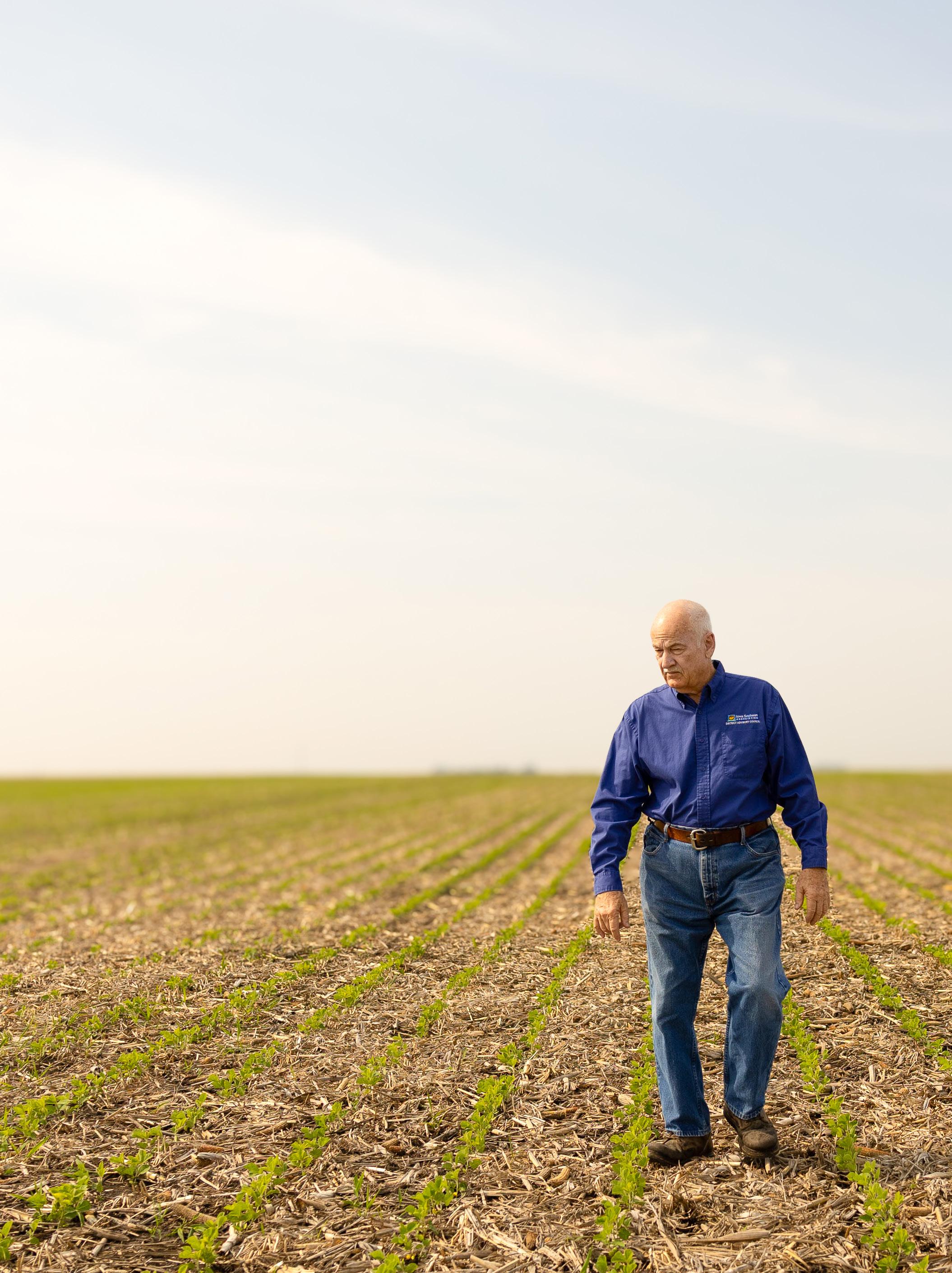
Ron Heck inspects a field near Perry.
They want protection from disease, pests and herbicide stress, along with economic traits that help them manage inputs in a tighter market.
Our current weed control systems, like Enlist®, have been a big step forward, but growers are still asking for continued innovation in herbicide trait options to stay ahead of resistance and do the best job possible at killing weeds.
In environments of subdued commodity prices, growers are doing everything they can to “bushel their way out” — maximizing every acre with earlier planting, strategic management and selecting the highest-yielding, most agronomically balanced products available.
As an agronomist, it’s encouraging to see how quickly farmers are adapting — and it's our job to stay one step ahead, helping deliver genetics that not only yield but stand strong against everything nature throws at them.”
Contact Kriss Nelson at knelson@iasoybeans.com
STORY BY KRISS NELSON | PHOTOGRAPHY BY JOCLYN KUBOUSHEK
FIVE STEPS to Seed Selection
Seed selection strategies to inform your decision making
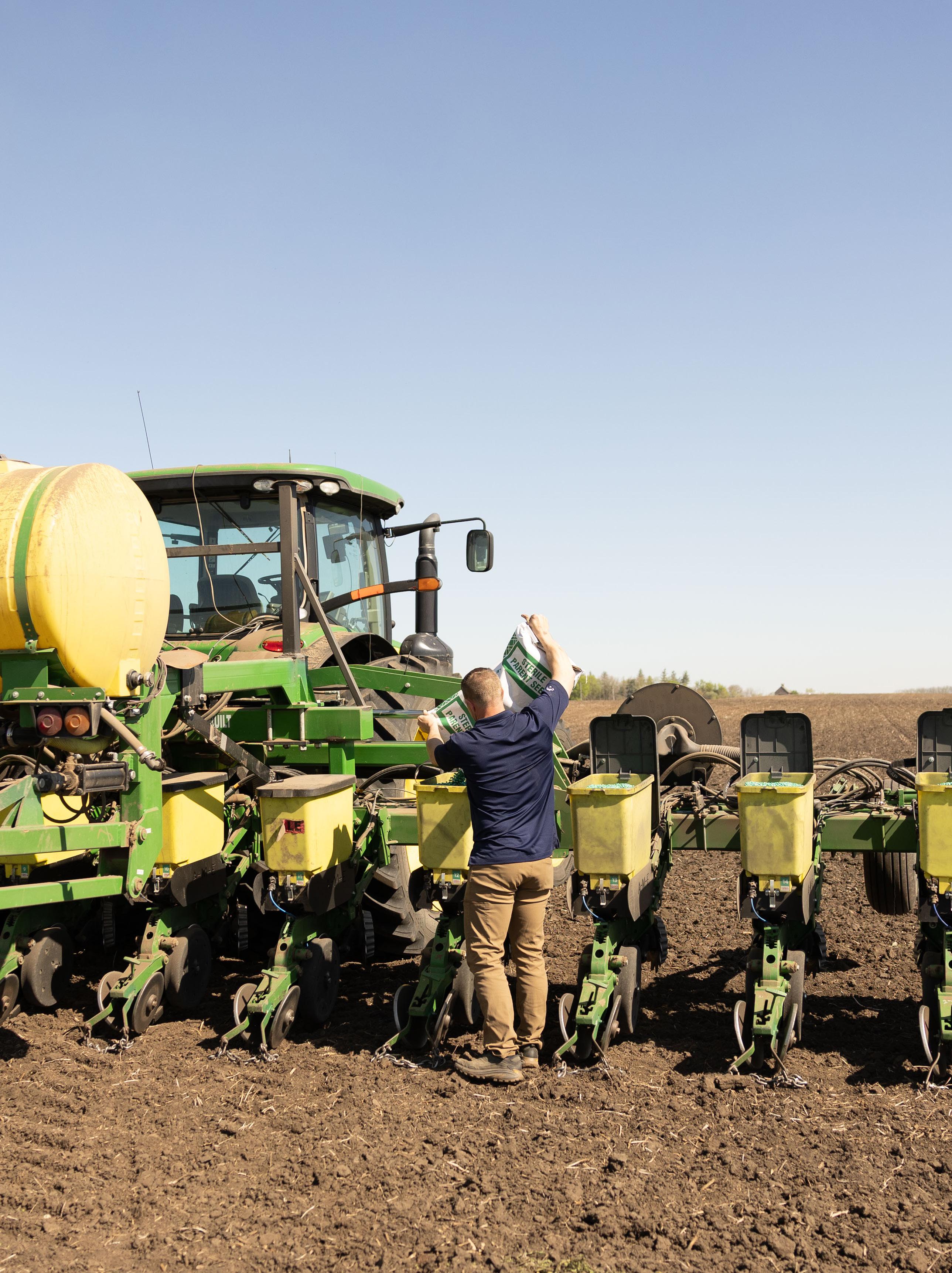
From unpredictable weather to relentless weeds, insects and disease, every growing season brings its own set of challenges. But the strongest line of defense starts long before the planter hits the field: it starts with seed selection.
As the early order window creeps up, it’s time to think ahead and secure genetics that can withstand whatever the 2026 growing season throws our way.
Iowa Soybean Association (ISA) Research Agronomist Shane Beck and ISA farmer-member Matt Wyatt, a Latham and LG Seeds salesman, share their five key considerations to guide your soybean seed decisions for next year.
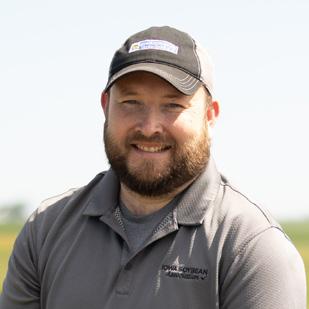




Shane Beck, ISA research agronomist

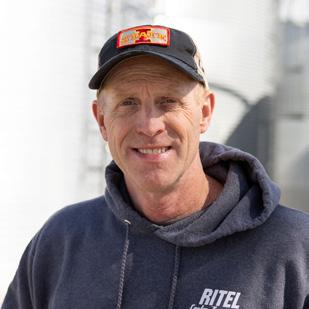
Wyatt, LG Seeds and Latham salesman
1: PEST PROTECTION
Soybean yields suffer significantly from weeds and insects, which compete for resources and directly harm plants. Choosing seeds with builtin protection helps safeguard yield from these threats.
Choosing hybrids and varieties that fit into a wellbalanced chemical program for weed control is essential.
“Don’t use the same herbicides for both corn and soybeans,” says Beck. “Unfortunately, soybeans have a limited number of herbicides that are


Maturity is an important factor to consider when purchasing seed.
“Full-season maturities offer the most upside when it comes to yield potential, but there is also a risk of an early frost killing the soybean plant before it is fully mature, resulting in a loss of yield,” says Beck. “Having a range in maturities can help spread out this risk.”
There can also be an advantage to planting an earlier variety, especially if cover crops are part of your operation, Beck says, allowing for early fall
effective against post-emergent weeds, so to help maintain the effectiveness of these chemicals, it is best not to use them in corn as well. It is better to use different herbicides and modes of action to manage the weeds during corn years of rotation.”
Some examples include the use of 2,4-D and Glufosinate in both corn and soybeans. According to Beck, this can lead to the development of early resistance to those herbicides. For above-ground insect and herbicide tolerance in corn
following soybeans, Wyatt advises traits with DoublePro or PowerCore to provide aboveground insect protection and herbicide tolerance. In corn-oncorn situations, farmers may consider a SmartStax or SmartStax Pro, which is designed to provide broad-spectrum insect protection, including both above-ground and below-ground pests, as well as herbicide tolerance.
For soybeans, Wyatt looks for traits with XtendFlex or Enlist traits which provide advanced weed control through herbicide tolerance.
2: MATURITY
soybean harvest to give the cover crops a head start on growth going into winter.
Where you farm and how early you want to plant and harvest will help decide which maturity group to use.
Wyatt, who farms near Reinbeck, says soybeans farmers in his area plant a range of 1.8 to 3.0 maturity, depending on when they want to harvest.
“It seems the later maturity soybean, the better results,” says Wyatt. “As long as you get the right weather, the later the maturity, the
better the yield potential.”
Wyatt says they aim for 102to 114-day maturity corn. This allows farmers to spread out the timing for when their corn is ready for harvest.
“Spreading out corn maturities can also be beneficial because it can spread out the pollination window, which can help mitigate the risk of a hot week during pollination where the corn might not pollinate as well as we would like, thereby reducing yield,” says Beck.
Continued on Pg. 14
Matt


3: DEFENSE
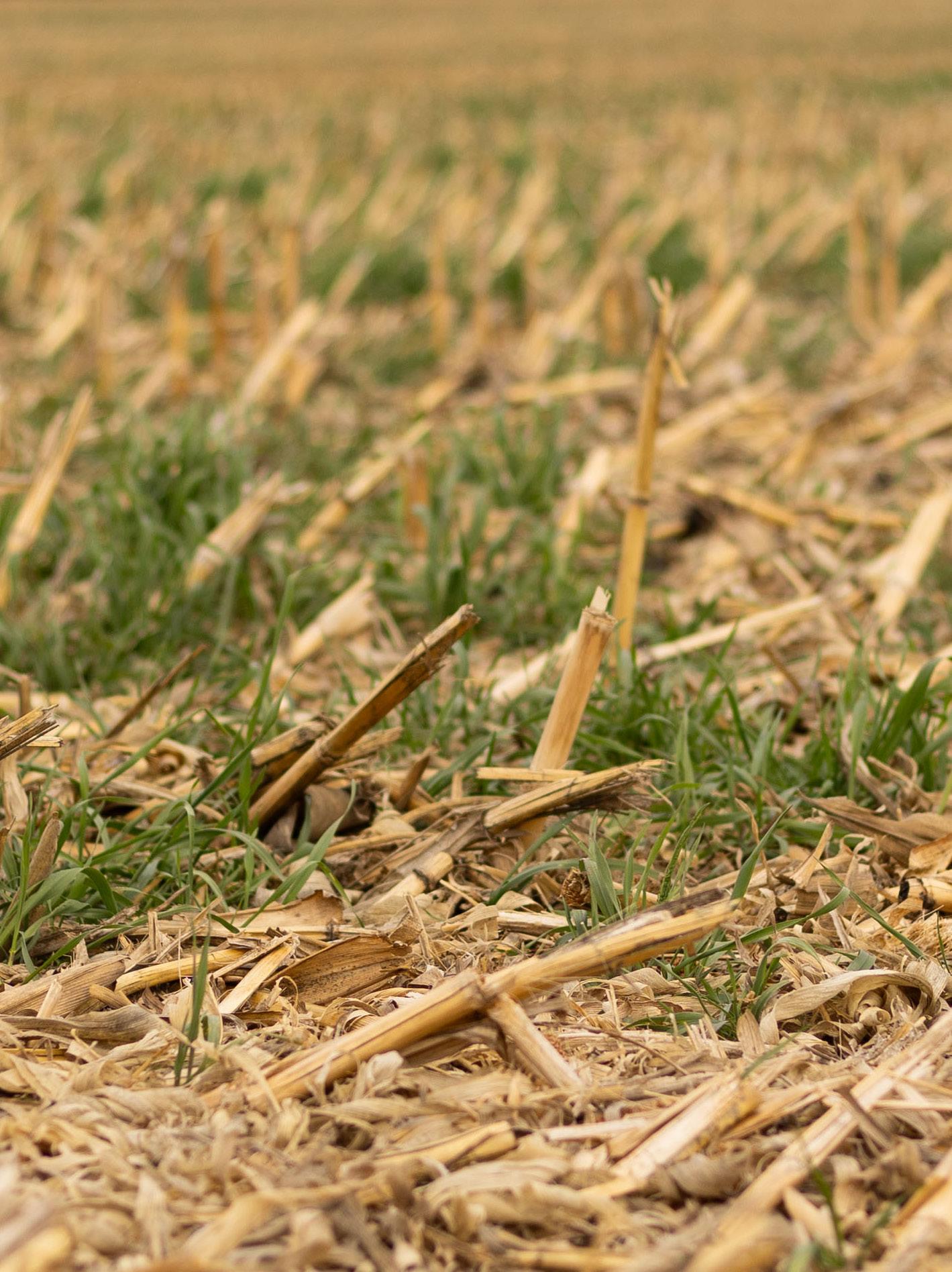
Some varieties of corn and soybeans offer a tougher defense against diseases.
“Seed companies test their products against common diseases in the area and give them a rating on how well they protect against those diseases,” says Beck. “Knowing what diseases are common in your field can help when choosing a hybrid
or variety best suited to deal with that pest.”
Consider each field individually; its history will guide the best course of action.
“If you have had a disease on your farm in the past, you want to plant a variety that shows tolerance to that disease,” says Wyatt. “Tar spot in corn, for
example, there seem to be some numbers that are showing resistance, then there are others that are very susceptible to it.”
Some soybean varieties, Beck says, are also better suited to do well in the presence of nematodes or a nutrient deficiency like Iron Deficiency Chlorosis.


According to Wyatt, the practice of planting soybeans before or with corn is gaining traction. To secure replanting coverage, most farmers adhere to the federal crop insurance deadlines.
“This year, crusting soils caused some replanting, but more people seem to take that risk to


4: EMERGENCE
get the highest potential for yield by planting as early as possible,” says Wyatt.
Choosing a seed variety and hybrid that emerges well under stressful and cooler conditions for planting early is important, but that might not be enough.
“Planting early can lead to the seed remaining in the soil for a significant amount of time before it emerges,” says Beck. “Including a seed treatment can help protect the seed from diseases and insects while it is underground, which can help ensure a high-quality stand.”
5: CONSISTENT YIELDING VARIETIES
Knowing where your higherand lower-performing fields are will help you choose a variety that consistently yields.
“Different seed genetics perform differently in different environments,” Beck says. “Some will do well in sandy, poorerperforming soils, but not as well on the better soil.”
Farmers shouldn't focus on varieties that yield the highest in only a single year or perform well in
only specific locations, Wyatt says.
“You should consider looking for a variety that is consistently toward the top of yield trials in your area,” he advises.
Seed companies replace hybrids and varieties quickly, which means a variety that has consistently performed well on your farm may no longer be available, Wyatt and Beck say.
“This can be frustrating, especially if it's your top choice
going into next year,” says Beck.
“One bright spot might be talking with your seed salesman or doing your own research to see if there is another variety that may be related to your top performer. It could have a slightly different trait package or be a cross of one different parent, and it might be your next top performer on your farm.”
Contact Kriss Nelson at knelson@iasoybeans.com


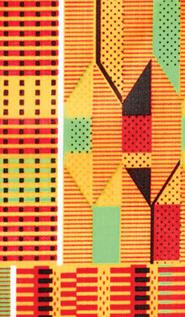
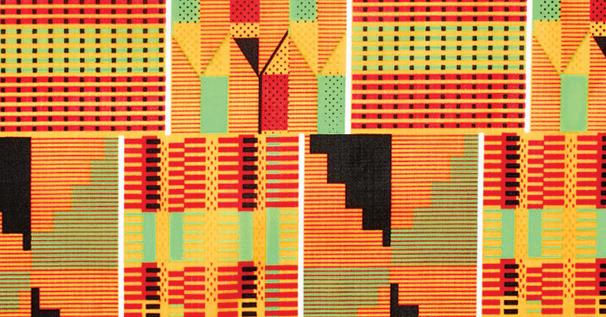
Put Your Fields to the Test
Enroll in ISA farm trials this fall
STORY BY PHOTOGRAPHY BY KRISS NELSON JOCLYN KUBOUSHEK
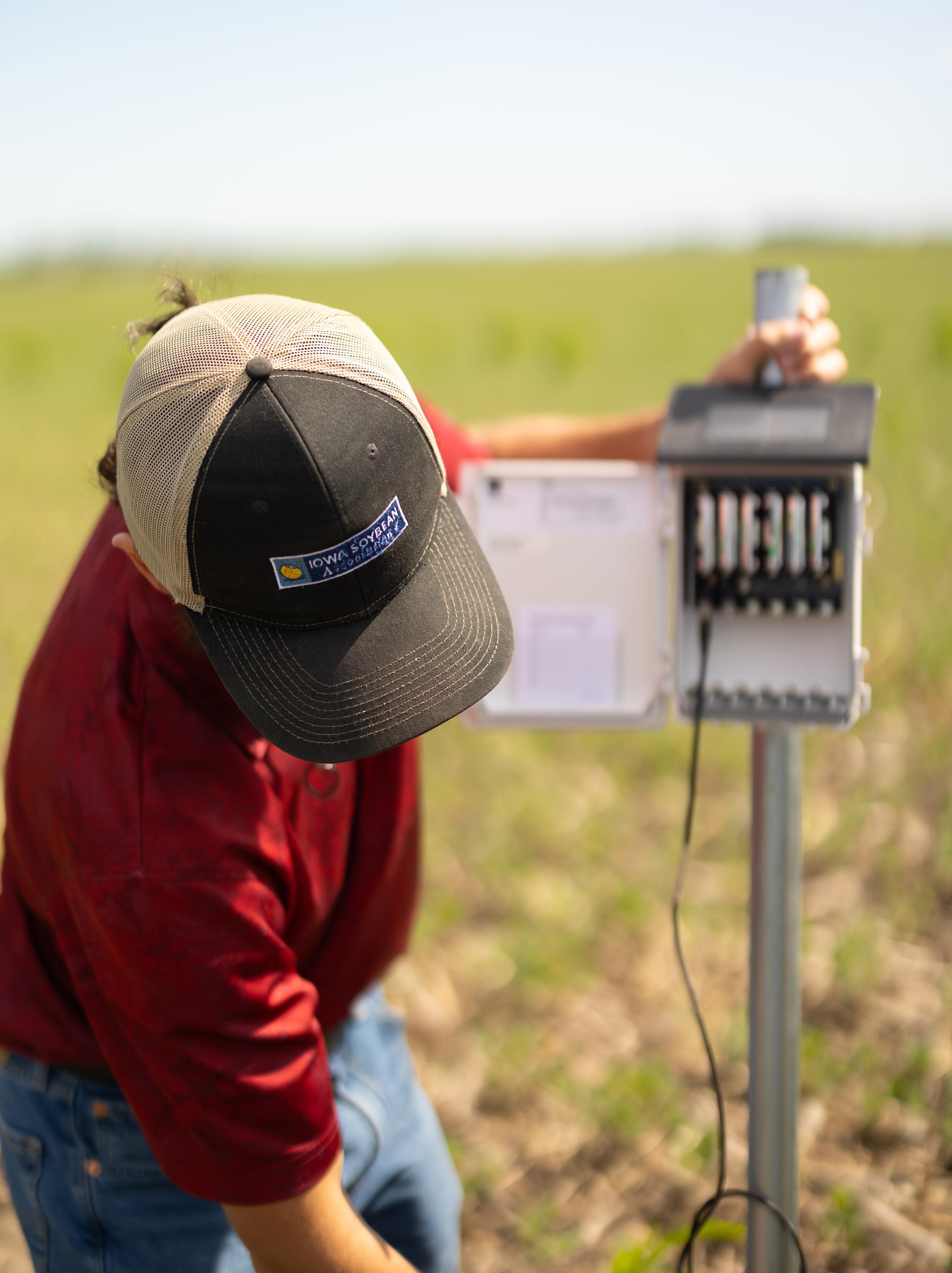

The Iowa Soybean Association (ISA) is enhancing its research program to include a wider range of topics and a stronger emphasis on economic impact.
“Everything we are doing in our research is to find a path forward that is going to make it more profitable to be farming in the state of Iowa,” says Alexander Litvin, Ph.D., ISA research agronomy lead. “Research can help farmers reduce costs and maximize profits by improving productivity and reducing input needs. By combining this with conservation, we secure the farm’s future for generations.”

Scan the QR code for trial participation information
Alexander Litvin, Ph.D., ISA research agronomy lead
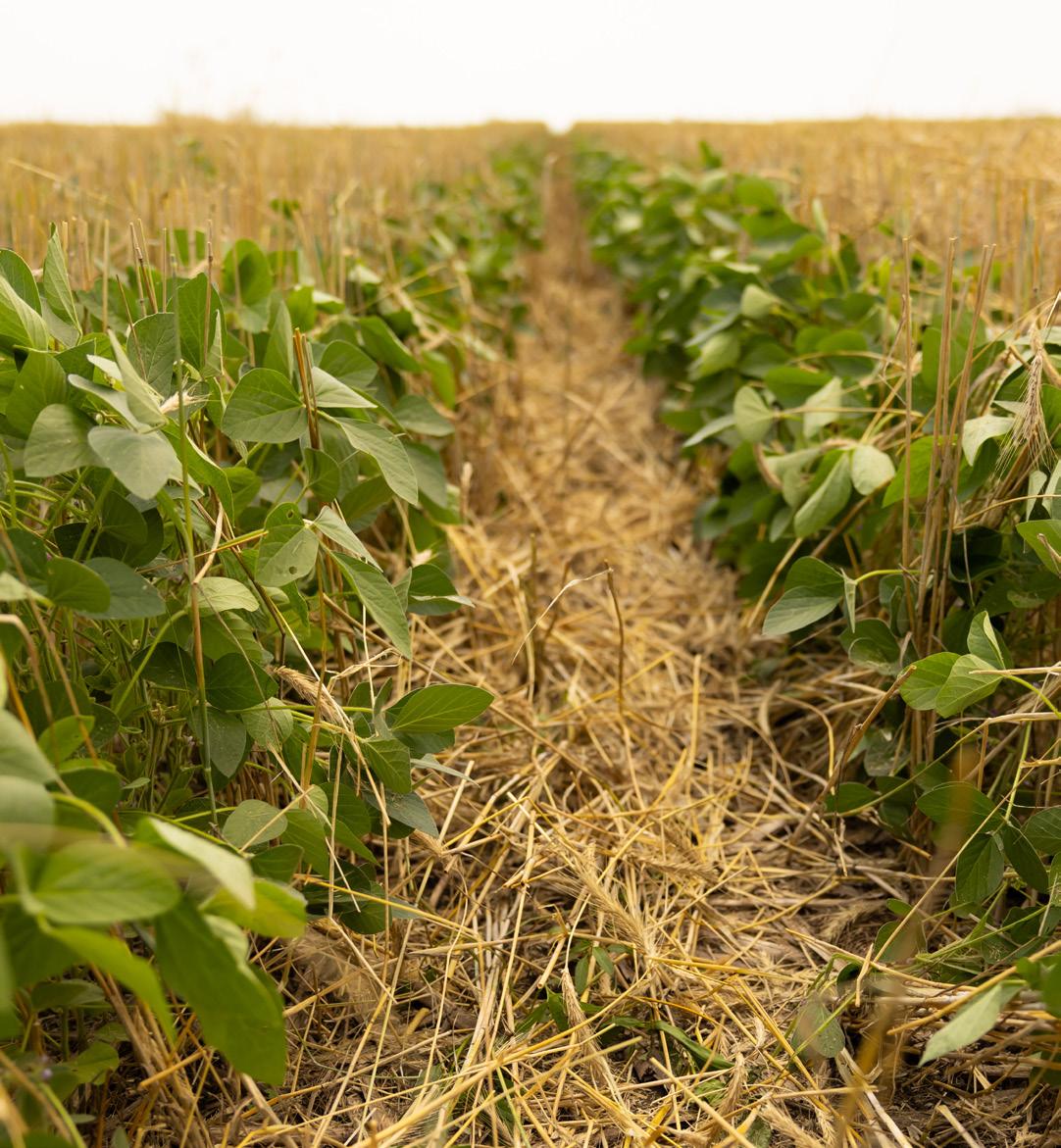
Improved cropping systems
This two-year trial employs a systems approach, combining cover crops and management techniques to enhance soil health and crop yields, rather than relying solely on rye cover crops. Cover crops, applied by drilling or drone in the fall, are terminated before planting and then reseeded after harvest.
The cover crop mixes used should accelerate and improve the economic feasibility of integrating cover crops into corn and soybean production.
Ahead of corn, a mix of triticale, hairy vetch, camelina blend and a nitrogen inhibitor will be applied in the fall.
A mix of rye, triticale and camelina will be applied before the soybeans.
In the last two years remaining of this 4-year project, ISA is exploring an improved species blend to be implemented this fall.
“We’re applying a different blend of cover crops for corn than for soy,” he says. “The goal is to dial in and see which blend performs better. So far, the results for the corn blend have been extremely promising, and now we’re working to optimize it further for soy.”
Litvin says the improved cropping systems trial is an excellent opportunity to improve crop performance and soil health while being compensated with both free cover crop seed and payment. The program will pay farmers $750 for soybean trial areas and $1,000 for corn trial area participation.


INCREASE
HARVEST EFFICIENCY
Rely on Unverferth for a complete lineup of grain carts that will increase harvest efficiency.
The X-Treme® 19-Series features a front-folding single-auger design with enhanced forward reach for greater unloading visibility. The 60-Series side-folding single-auger grain carts maximize side and unloading reach. The 20-Series dual-auger grain carts offer a pivoting vertical auger, rubber-cushioned tongue suspension, and a low-profile design with large carrying capacities and fast unloading speeds.
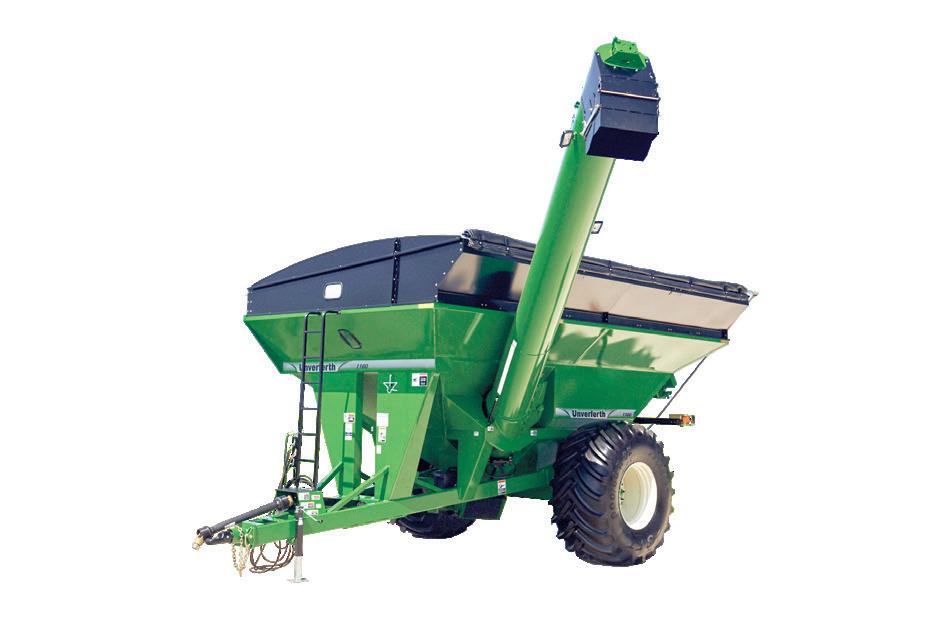
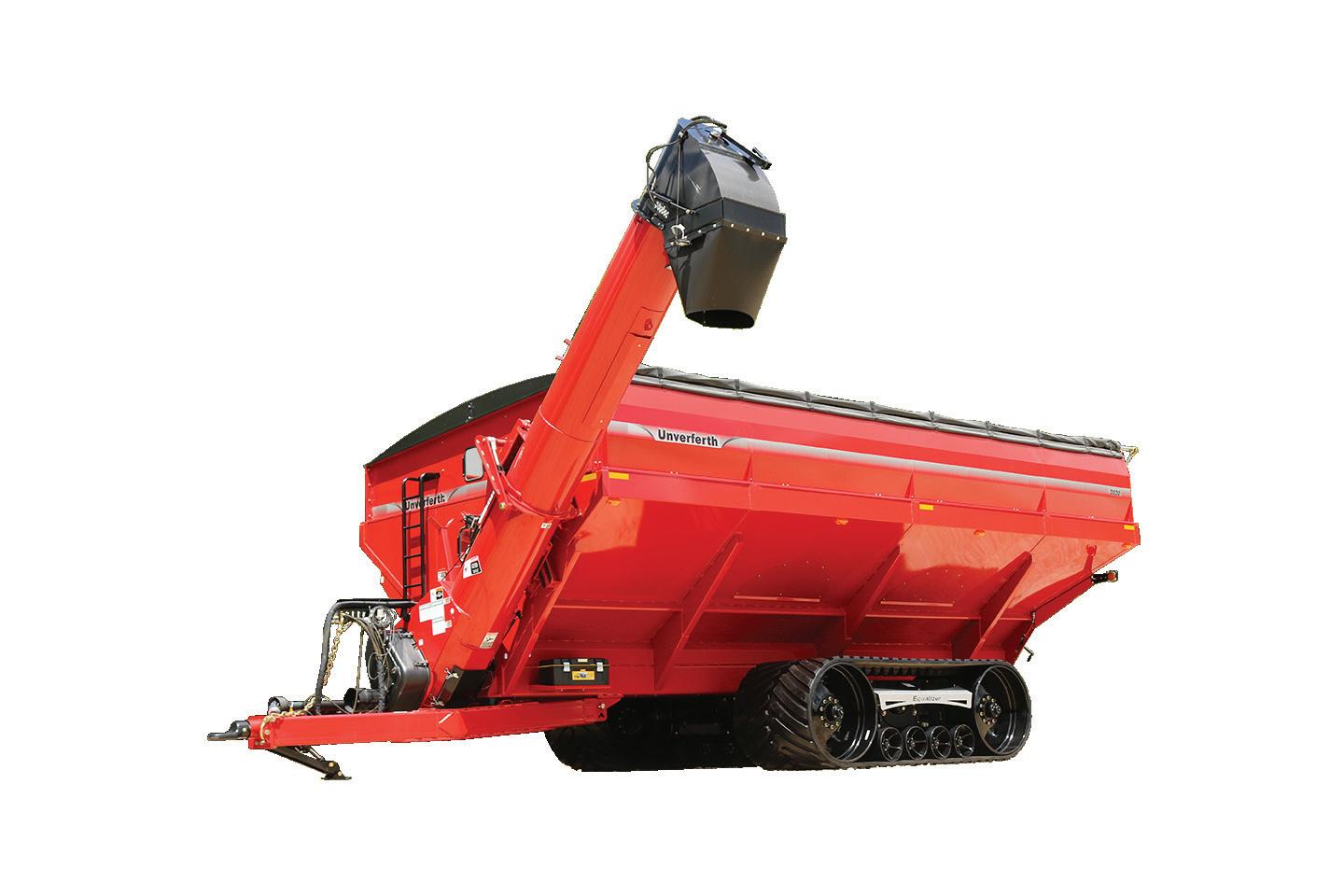
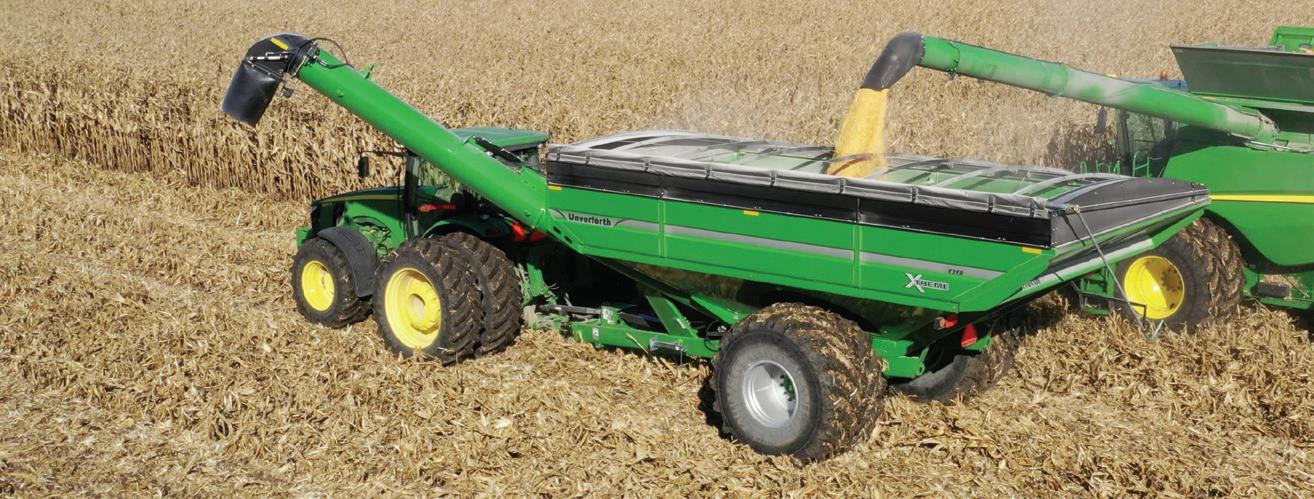
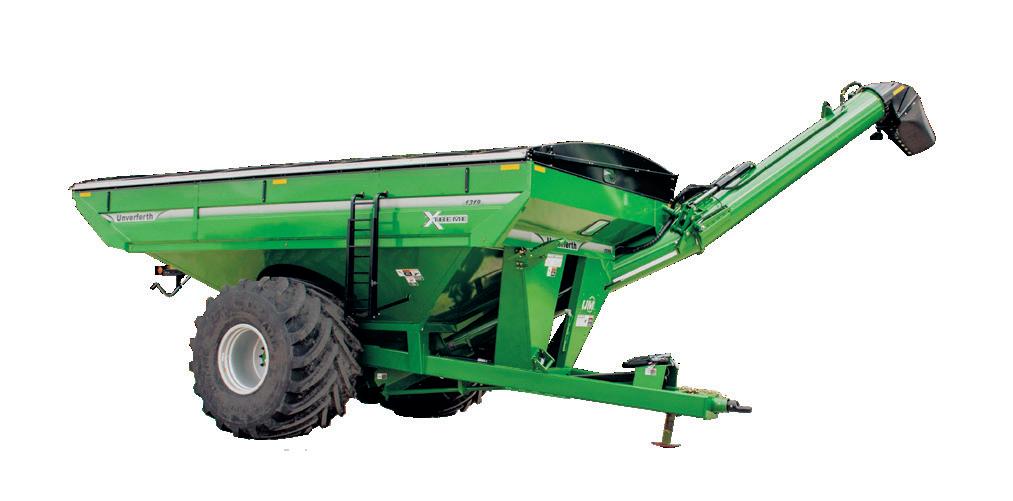
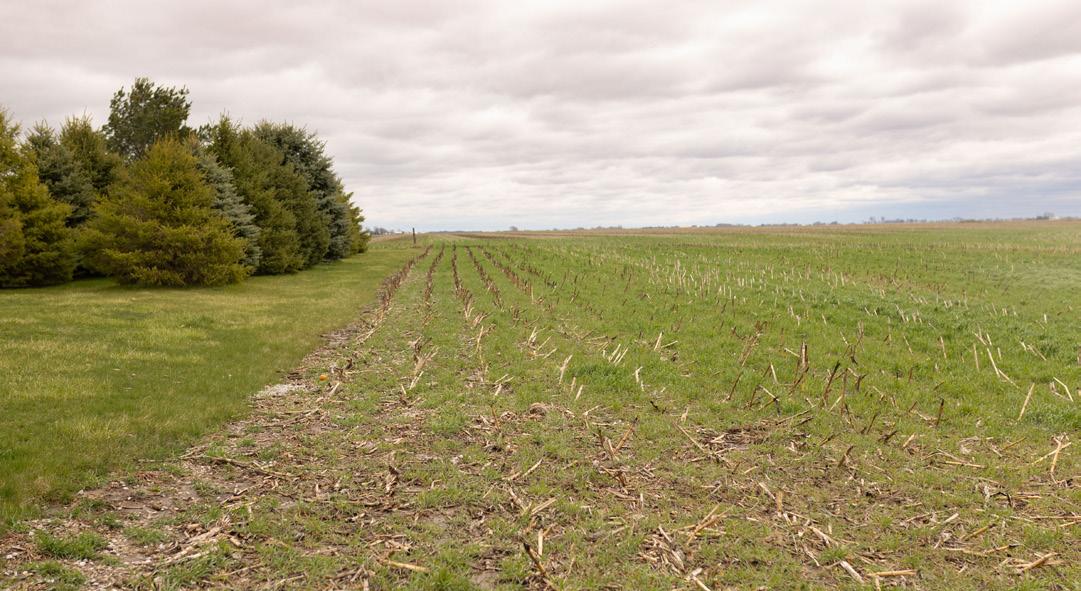
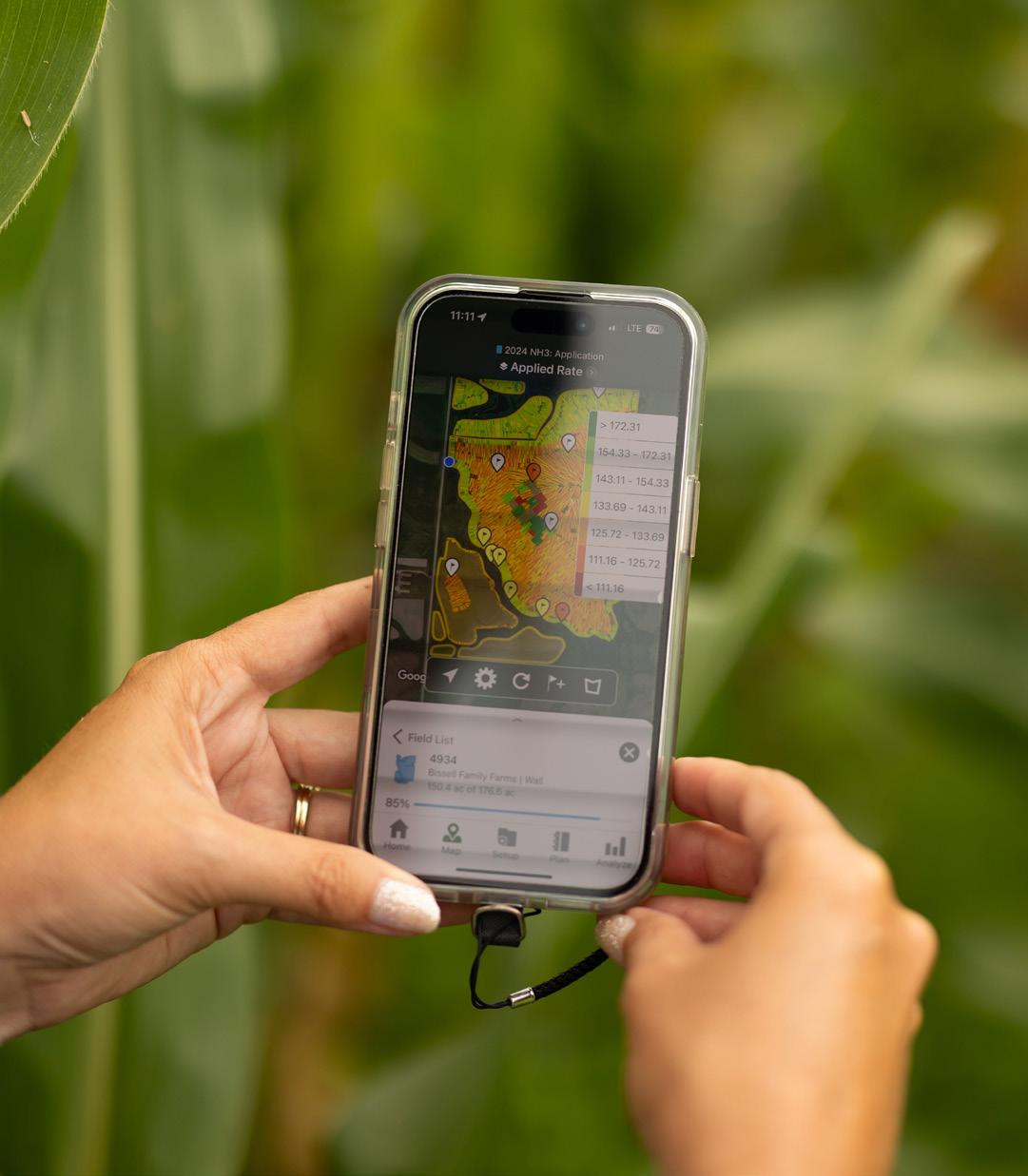
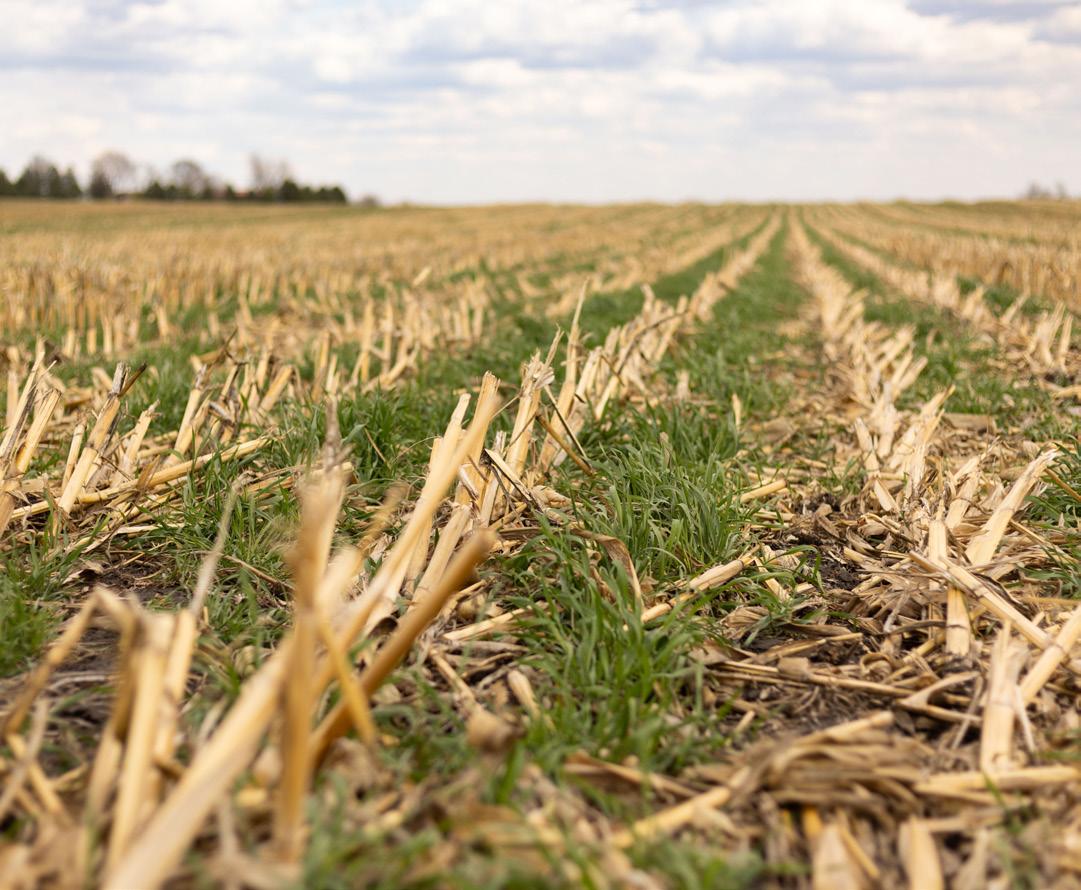
Residue management in soybeans
This trial will investigate corn residue management using microbes and biostimulants, and the products’ impact on return on investment (ROI).
In this trial, farmers will apply BW Fusion Meltdown to corn residue post-harvest in fields they will plant with soybeans the following year.
Litvin says residue breakdown may aid in improved nutrient availability, better stand counts due to improved planting efficiency, and faster fieldwork in the spring.
The study plans to investigate these potential savings from efficiency gains and weigh them against overall crop performance.
Iowa Nitrogen Initiative
The goal is to collect data from hundreds of locations of five-rate nitrogen trials to improve the Maximum Return to Nitrogen (MRTN) tool and support various crop modeling and predictive models, thereby enhancing nitrogen use efficiency and farm profitability. The only participation requirements are yield maps from previous years, a calibrated yield monitor and access to equipment that can apply nitrogen at different rates across the field.
Five different nitrogen treatments will be applied within each block according to a prescription made by the Iowa Nitrogen Initiative team.
Using past yield maps as a guide, researchers strategically position blocked trials in high- and low-yielding areas of the field. Farmers who agree to include a zero-rate treatment for their fields will receive compensation of $600.
Although yield maps can help determine trial placement in the field, farmers can also sufficiently guide the placement by indicating consistently high- and low-yielding areas year after year.
By participating in the Iowa Nitrogen Initiative, participants receive annual results with recommendations on their economic maximum return rate, guiding their practices from one year to the next.
“This trial informs farmers of their economic maximum return for nitrogen application,” says Litvin. “The report details their most profitable point financially for their productivity levels.”
Phosphorus and tillage
This trial will compare the applications of Monoammonium Phosphate (MAP) or Diammonium Phosphate (DAP), whichever the farmer prefers, in no-till or conventional till, with applications of RhizoSorb in strip-till.
RhizoSorb helps meet the phosphorus requirements of crops by reducing binding to soil, gradually breaking down and releasing phosphorus to plants throughout the season.
“Often, the soil will bind to the phosphorus, reducing availability to plants, and limiting potential crop growth as the season progresses,” says Litvin. “The idea is to significantly reduce input costs for farmers through more efficient application of phosphorus, saving money without hurting yield.”
If you’d like to participate in an ISA trial this fall, contact agronomy@iasoybeans.com.
Contact Kriss Nelson at knelson@iasoybeans.com

IOWA SOYBEAN ASSOCIATION LAUNCHES
PARTNERS+ PROGRAM WITH A GI
STORY BY BROCK JOHNSTON | PHOTOGRAPHY BY JOCLYN KUBOUSHEK

In an innovative move to support Iowa farmers amid tightening margins, the Iowa Soybean Association (ISA) is launching a Partners+ Program with Ag Growth International (AGI) as its first participant.
AGI is a global leader in grain storage, handling, and conditioning systems. As an ISA Partners+ participant, AGI will provide ISA farmer-members discounts on in-bin digital monitoring systems and grain conditioning and handling solutions.
“This partnership is about equipping farmers with the tools and knowledge they need to be more successful while saving them money,” says Brent Swart, ISA president and soybean farmer from Spencer. “By aligning with AGI, we’re helping deliver opportunities that could help our members make smarter decisions,

reduce risk, and maximize the return on every bushel stored.”
AGI’s digital retrofit solutions — including smartphone-operated in-bin monitoring systems — offer farmers real-time visibility into grain conditions, helping prevent spoilage, reduce stress, and generate yearover-year performance data.
“We are delighted to partner with ISA, especially from a digital perspective,” says David Postill, senior vice president of AGI Digital & Global Marketing. “The goal is to help soybean farmers save or make money through operational upgrades while deepening our relationship with an association that does so much to advocate for the industry and agriculture.”
An in-bin monitoring system retrofit to an existing bin could transform how a farmer manages

grain in the bin — ensuring quality, increasing safety, providing realtime visibility, and preserving the value of their hard-earned crop.
“In a challenging ag economy, producers are seeking affordable upgrades that streamline grain storage, handling and conditioning,” Postill says. “This program delivers exactly that — providing additional insights that can make a farm more profitable.” Discounts are available to active ISA farmer-members. Verification of membership status will be confirmed before program benefits and discounts are applied.
Additional ISA Partners+ Program participants will be announced this fall.
To learn more about the program and take advantage of this offer, go to iasoybeans.com/partnersplus.
Contact Brock Johnston at bjohnston@iasoybeans.com
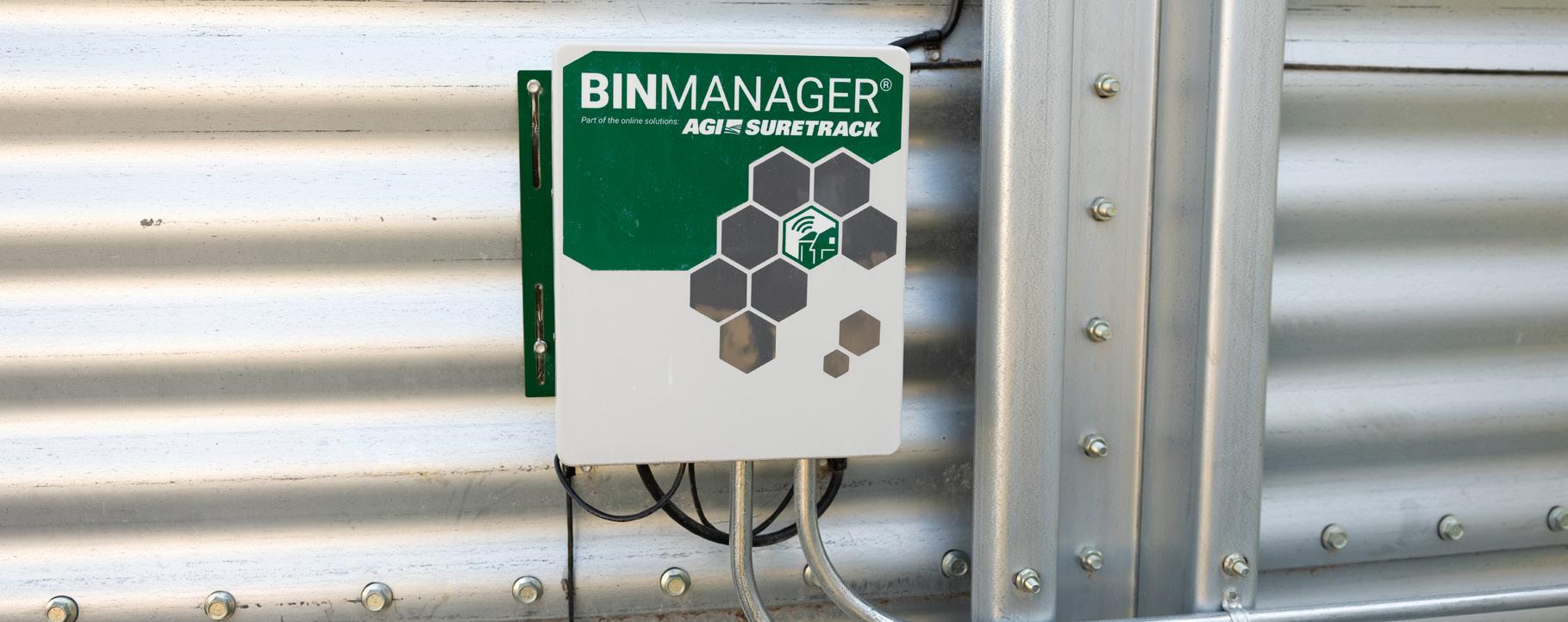
Soy Snaps
PHOTOGRAPHY BY
JOCLYN KUBOUSHEK
A collection of images capturing Iowa in the summer of 2025.
CLOCKWISE FROM MIDDLE:
Near Keota, Tom Adam inspects his growing wheat crop.
A close-up of food plot seed before planting.
Ruger, Logan Brooke’s loyal pup, waits patiently as the day’s farm work unfolds.
Blooming lilacs add color to a barn scene near Clarinda.
Logan Brooke, Lee Brooke and Trevor Hughes look over the herd at Brooke Farms.
Leighton Kroul stands by a feed bunk as she prepares to feed a steer near Mount Vernon.
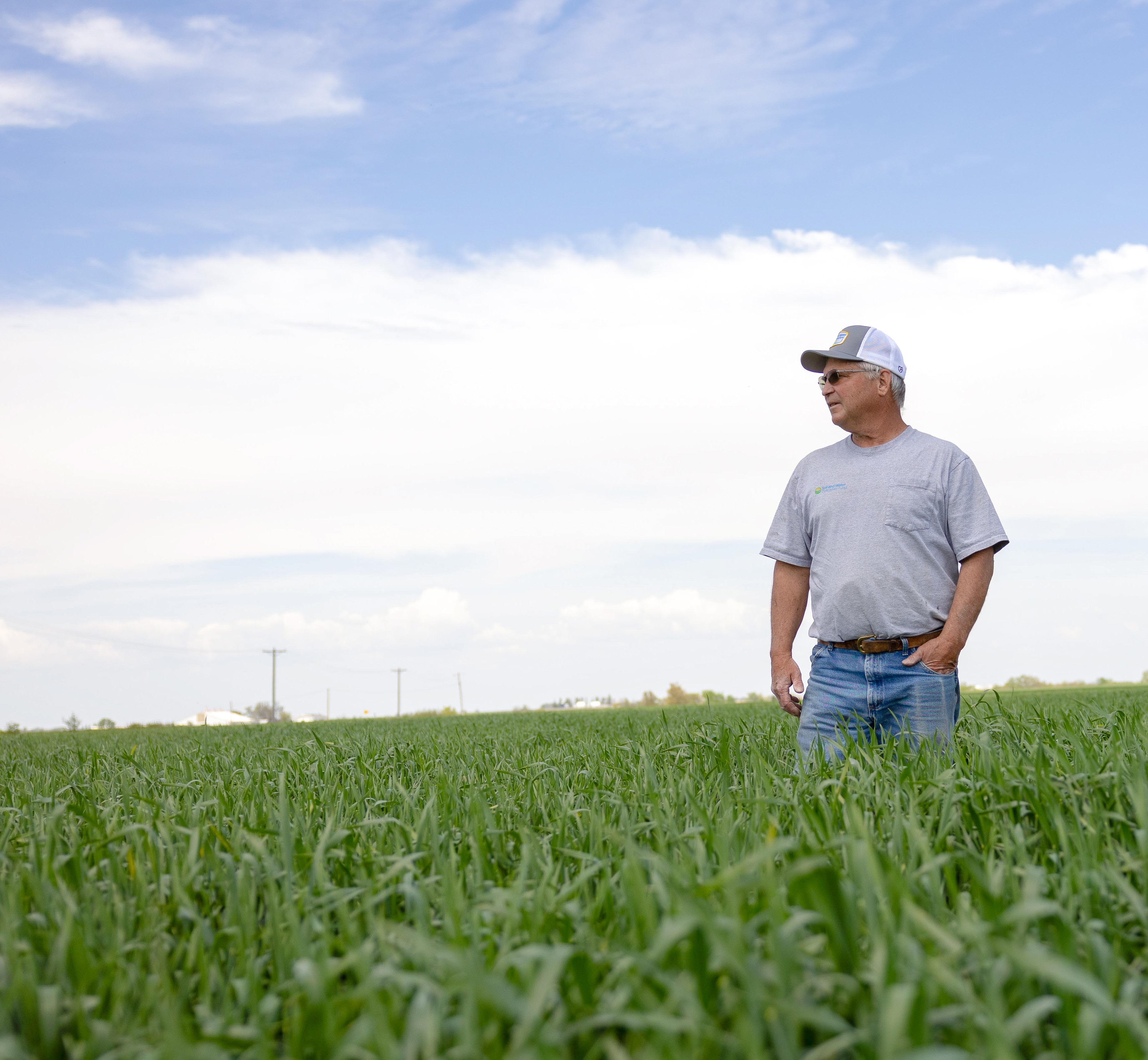
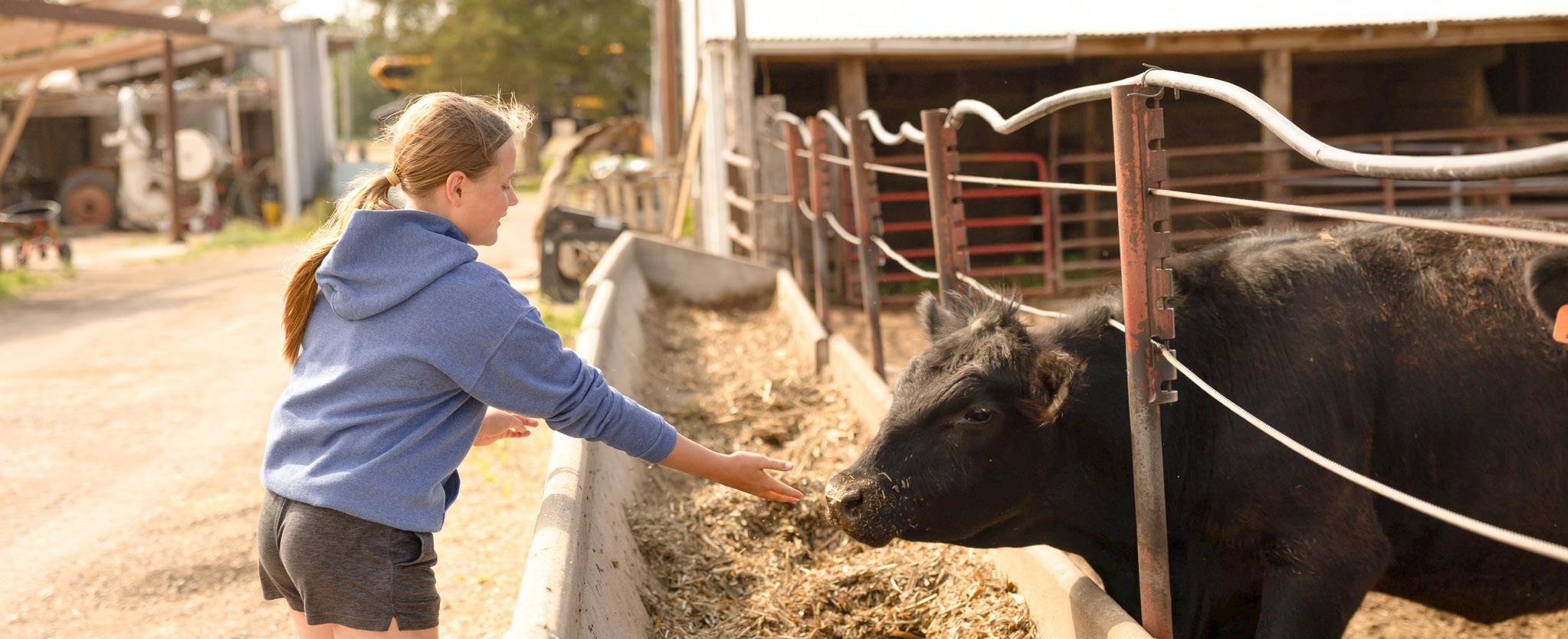


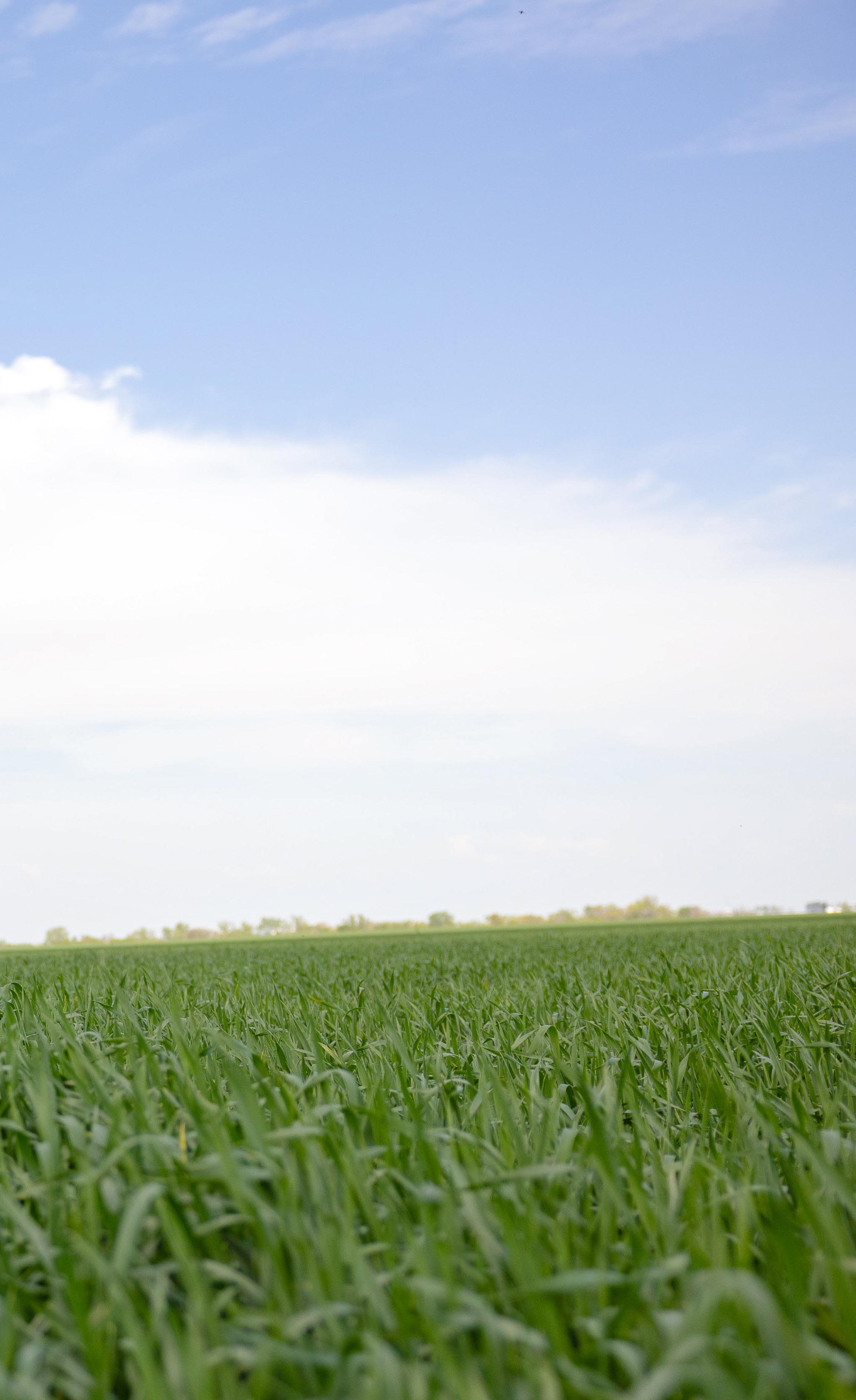
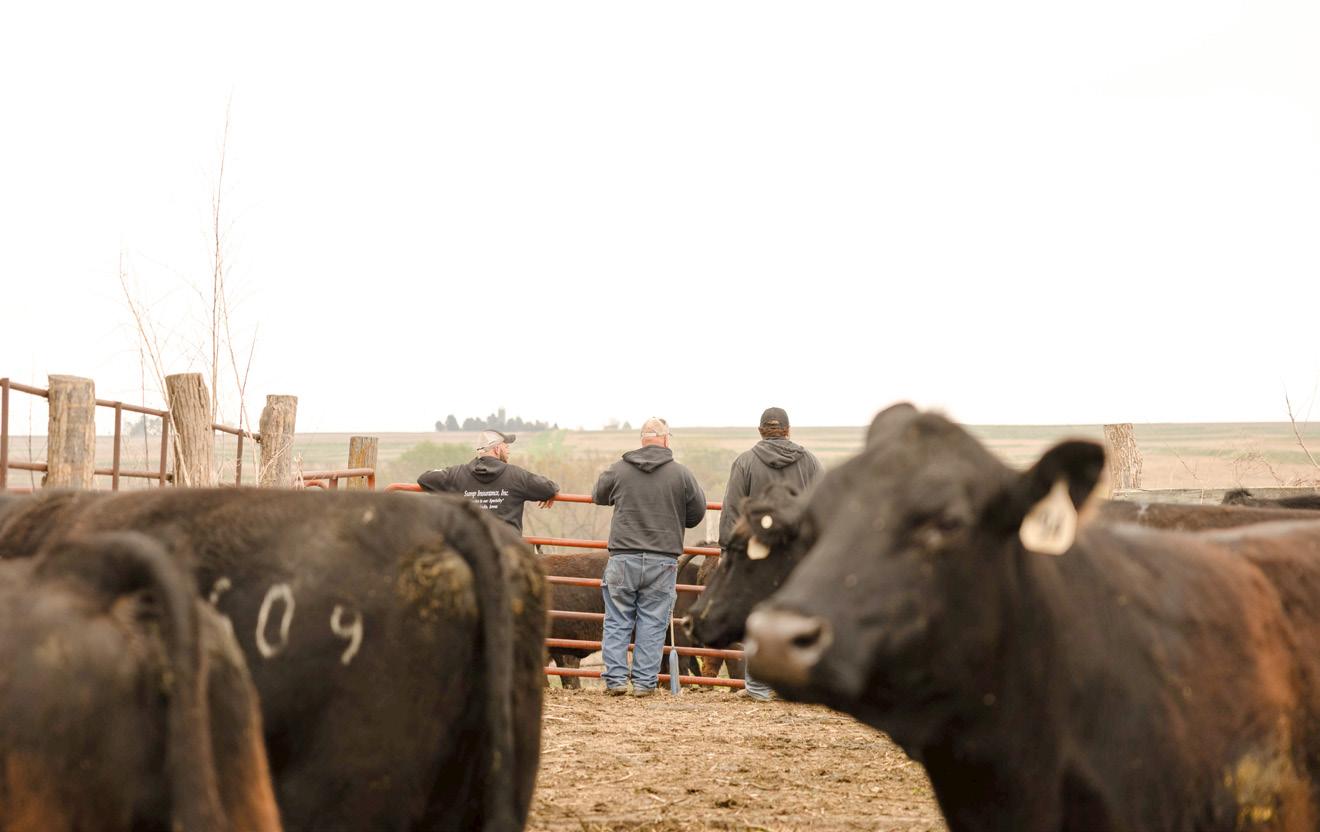
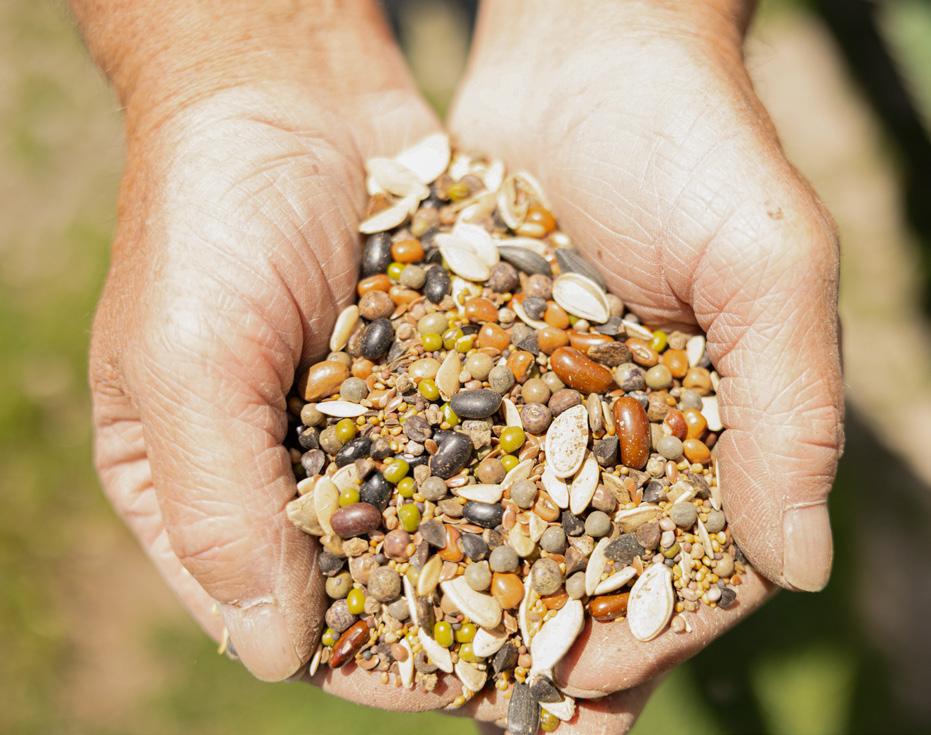
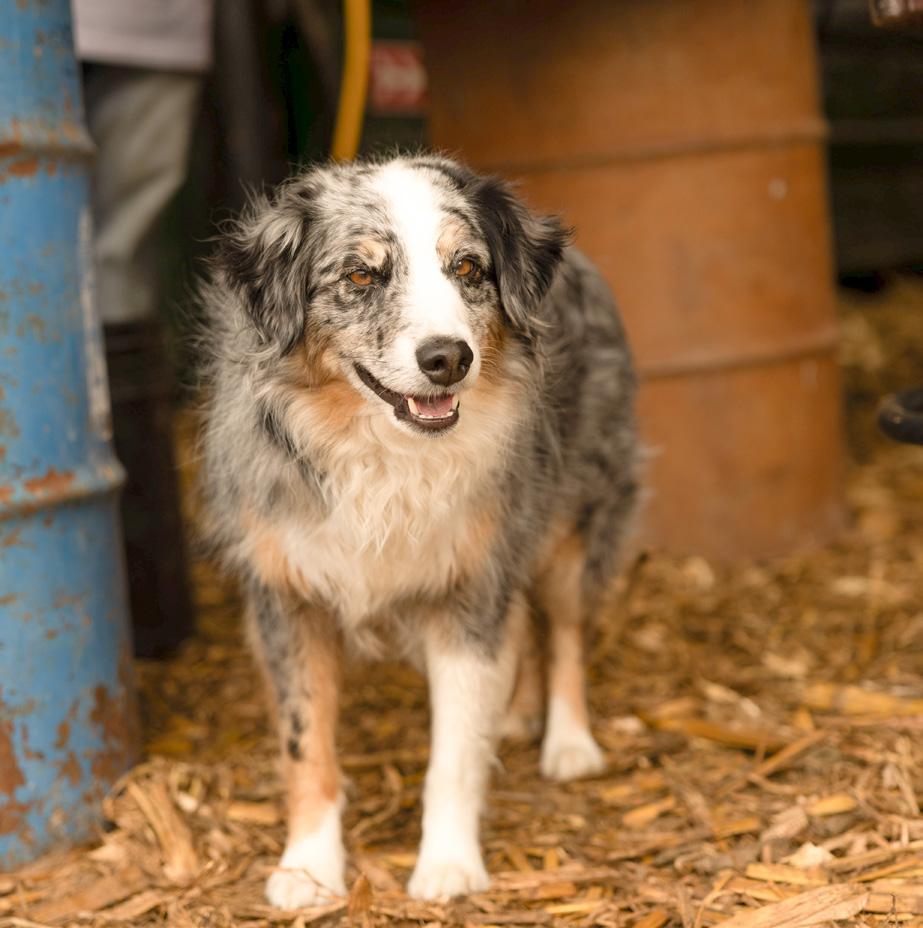
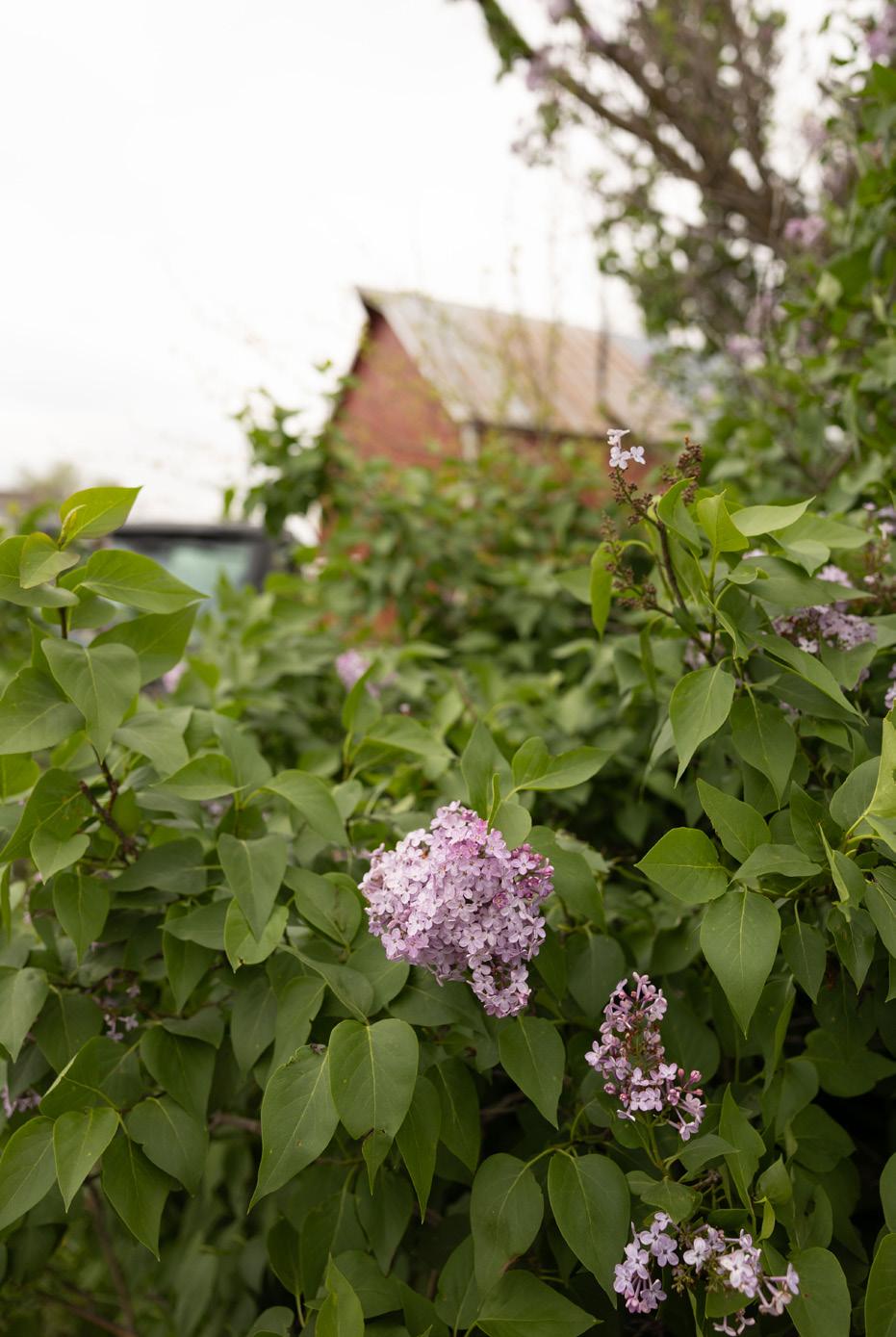


Long-Term Impacts of Cover Crops
Rosie Roberts ISA Technical Insights Manager rroberts@iasoybeans.com
KEY INSIGHTS
1. Yields between cover crop and no cover crop acres are comparable in corn and soybeans.
2. Cover crops improve soil compaction and aggregate stability.
3. Increased management of cover crops is critical, especially around termination timing.
Will cover crops drastically affect the cash crop’s yield? How do cover crops affect soil health and compaction? How do cover crops influence nutrient stratification throughout the soil profile?
In 2023, survey results showed that 3.8 million acres in Iowa were seeded to cover crops. Even with millions of acres utilizing cover crops, there’s a need for more researchbacked insights to guide best management decisions.
The Iowa Soybean Association (ISA) began studying the management influences and agronomic impacts of cover crops in 2016. It’s recognized as the longest on-farm cover crop study in Iowa.
Results from the nine-year, 25-farm study illuminated key learnings around yield drag, termination timing, soil compaction and soil nitrates.
Research participants split a field into replicated strips of cover crops compared to no cover crops within their traditional management systems.
Yield drag?
Soybeans with cover crops averaged 63.2 bushels per acre, while soybeans without cover crops yielded 64.6 bushels per acre. This 1.4 bushel-per-acre difference was calculated from 56 site-years of soybeans.
On average, corn following cover crops yielded 227 bushels per acre, compared to 229 bushels per acre without a cover crop. This two-bushel difference was determined after analyzing 72 site-years of corn across nine crop years.
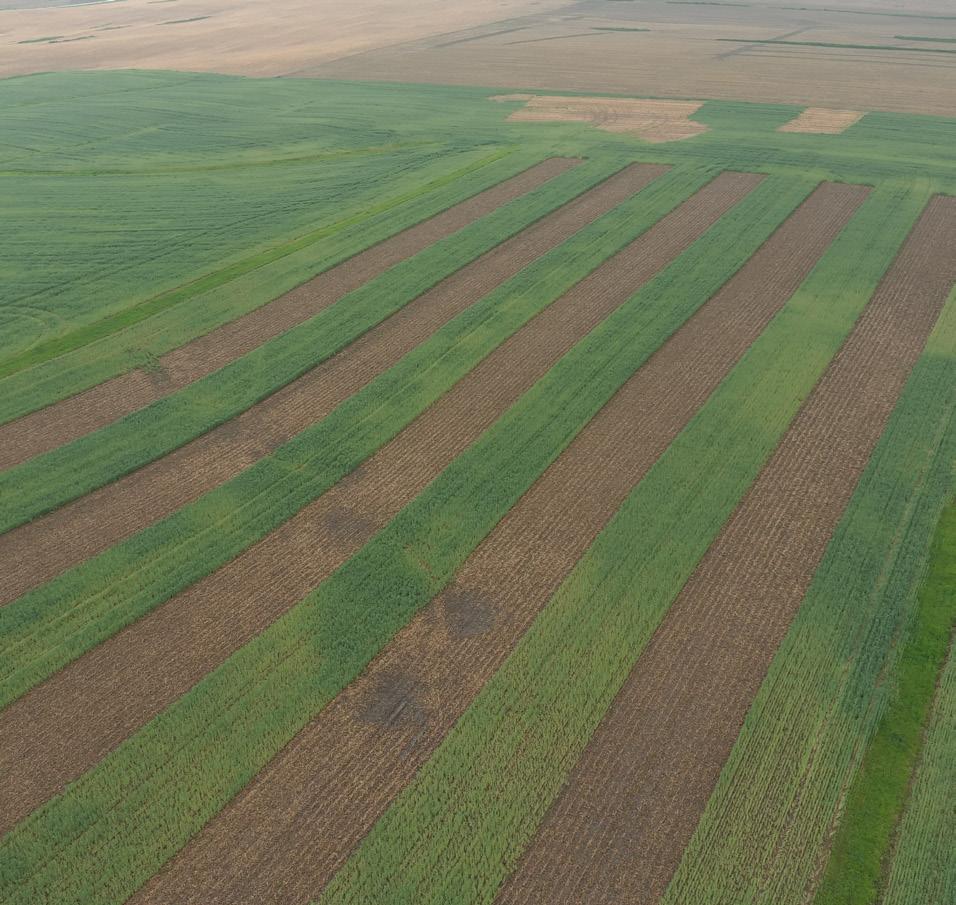
1. Strips with and without cover crops in field trial.
Across various soil types, weather patterns and latitudes, soybean and corn yields were comparable between cover crop and no cover crop comparisons.
Cover crops require an increased level of management to mitigate risks. Across all site-years yields were comparable, with the exception of 2017 and 2024’s wet spring. In years when termination timing was delayed, cover crop biomass
Figure
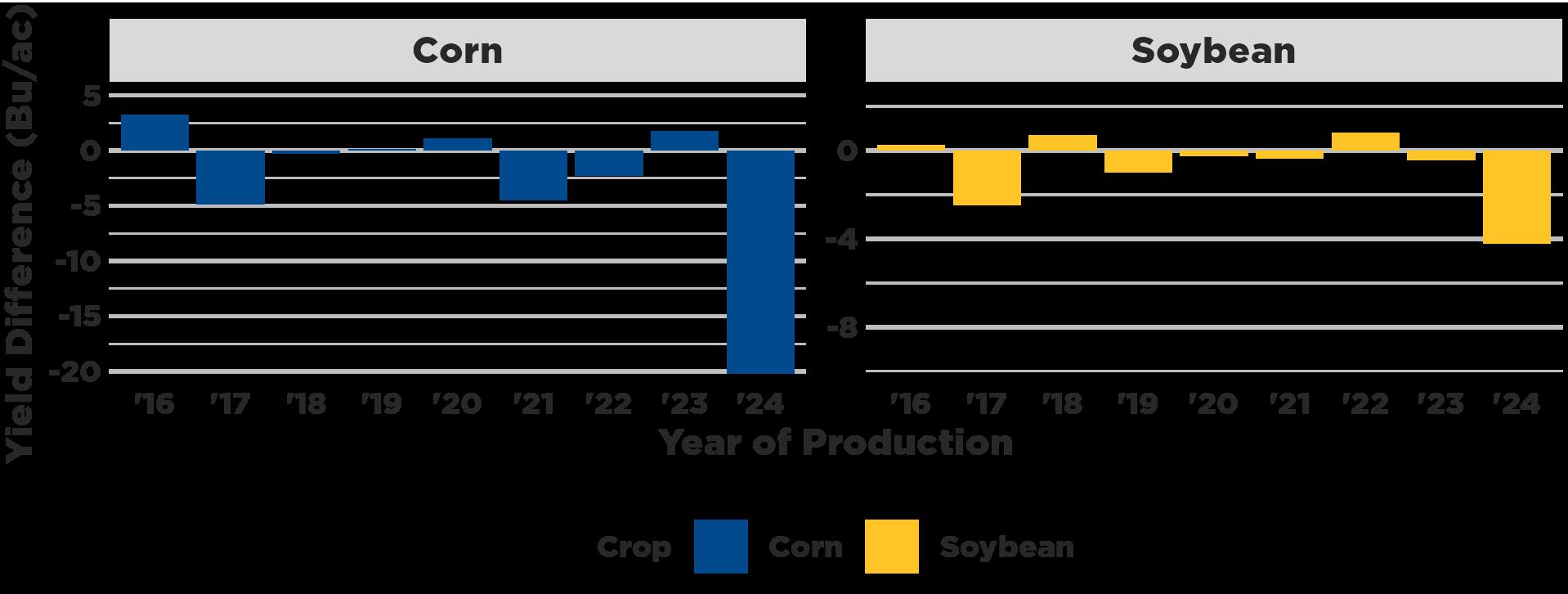
accumulated at higher rates. This overgrowth of cover crops and delayed termination timing had a strong negative effect on the following cash crop’s yield potential. Figure 2 shows the consequences of late termination and out-of-control residue.
Soil health effects
Aggregate stability, according to the U.S. Department of Agriculture (USDA), is a key soil health indicator, leading to improved soil structure, organic matter, nutrient cycling and biological activity. In this study, aggregate stability improved under the cover cropped acres, showing a noticeable increase when compared to the areas without a cover crop. ISA also soil tested for nine other soil health indicators, which resulted in comparable values between the cover crop and no cover crop treatments.
Soil compaction
In 2024, ISA assessed a subset of the participating locations for compaction differences. The cover crop acres showed a 6% reduction in soil compaction throughout the soil profile. Soil penetrometers were used to measure the compaction levels between treatments and locations. While there was a decrease in compaction, none of the sampled areas experienced yield-limiting compaction above 300 pounds per square inch (PSI). These results prove that
across varying soil types, cover crops significantly reduced soil compaction.
Nutrient stratification
Early season sampling from 0-24 inches deep showed cover crops reduced soil nitrates by 44%, confirming cover crop’s ability to scavenge excess nitrates in the soil profile.
The late spring nitrate test showed comparable nitrate levels in the top 0-7 inches of the soil; however, deeper, at 7-14 inches, the nitrogen concentration differed. Under cover crops, the deeper soil profile had 36% less nitrates than under no cover crops, showcasing the cover’s ability to influence nitrate levels at various soil depths.
This long-term cover crop research identified multiple benefits, answered agronomic questions, and enforces the timeliness of management decisions. Cover crops remain an effective tool for farm operation’s toolboxes to use on their path to reach their sustainability and production goals.
See the Insights Report, sent to you with this edition of the Iowa Soybean Review, for more research observations on cover crops.
This study is brought to you by Iowa Soybean Association in partnership with Iowa Corn Promotion Board and the Soil Health Partnership.
can consider it as a topic in a future issue. Better yet, we’ll connect you with your local expert so you can implement a trial on your farm.

Figure 2. Corn and soybean yields from 2016-2024.
New
pump opens in Iowa
STORY BY PHOTOGRAPHY BY BETHANY BARATTA
JOCLYN KUBOUSHEK
Heads turned as Adam King pulled up to the pump in his Wild Cherry Pepsi-branded semi. At the Pilot Travel Center, onlookers watched as he filled the tank with nearly 100% biodiesel — proving this was no ordinary day on the job.
On May 29, Iowa’s first aboveground B99 fueling pump officially opened for business — offering a blend of 99% biodiesel and just 1% diesel.
“Coast to coast, north to south, we try our very best to put biodiesel, renewable diesel and ethanol into every molecule of fuel we sell at Pilot,” says Eric Fobes, head of renewables at Pilot Flying J.
The installation of the pump represents a core pillar for the company — shaping the future of energy.
“To me and our customers it’s important that we are offering decarbonized solutions,” Fobes says. “This is one of those offers.”
Continued on Pg. 26

Eric Fobes, Pilot Flying J head of renewables

B99 Hits
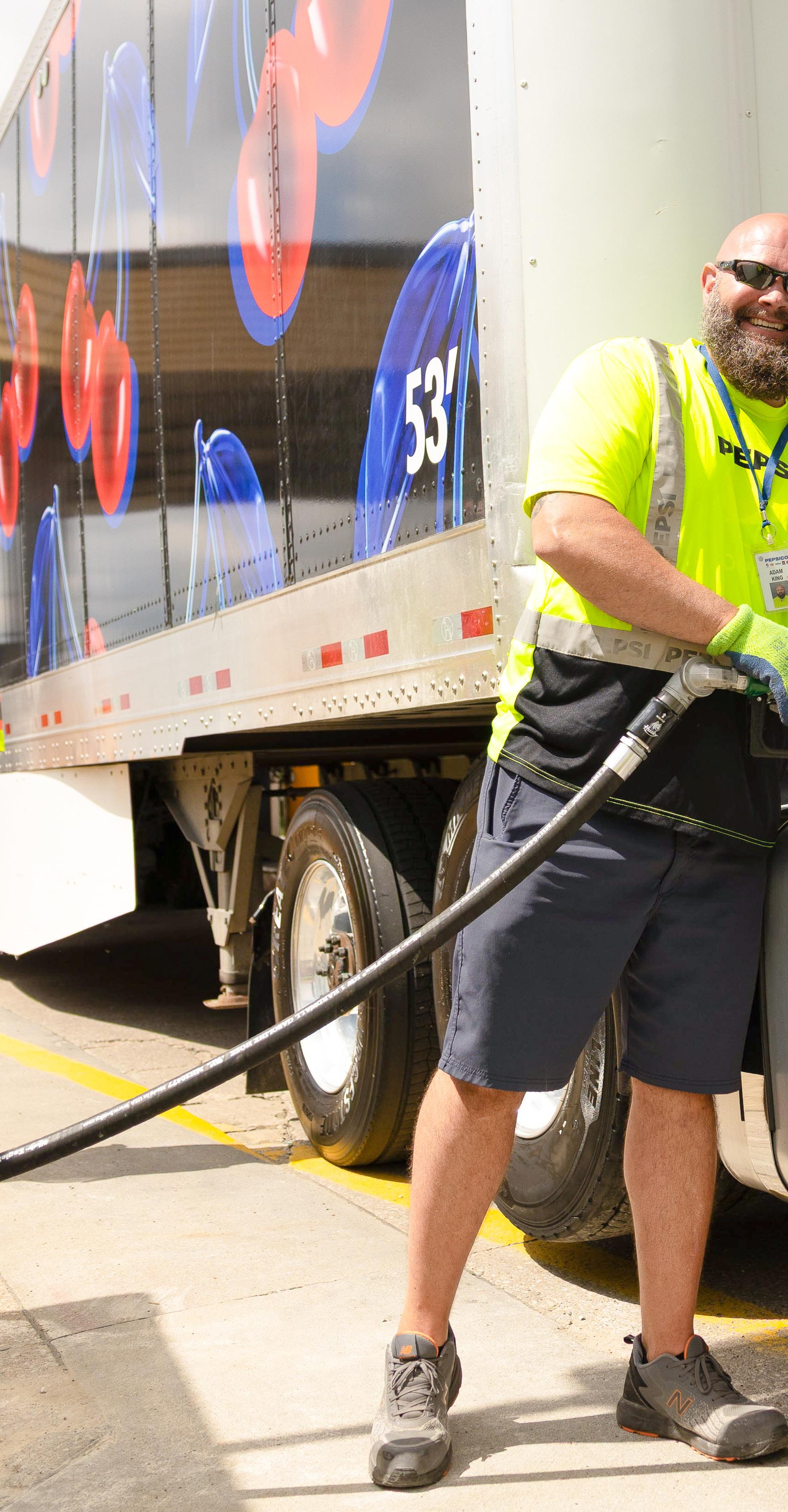
Adam King fuels up with B99.
Hits the Road


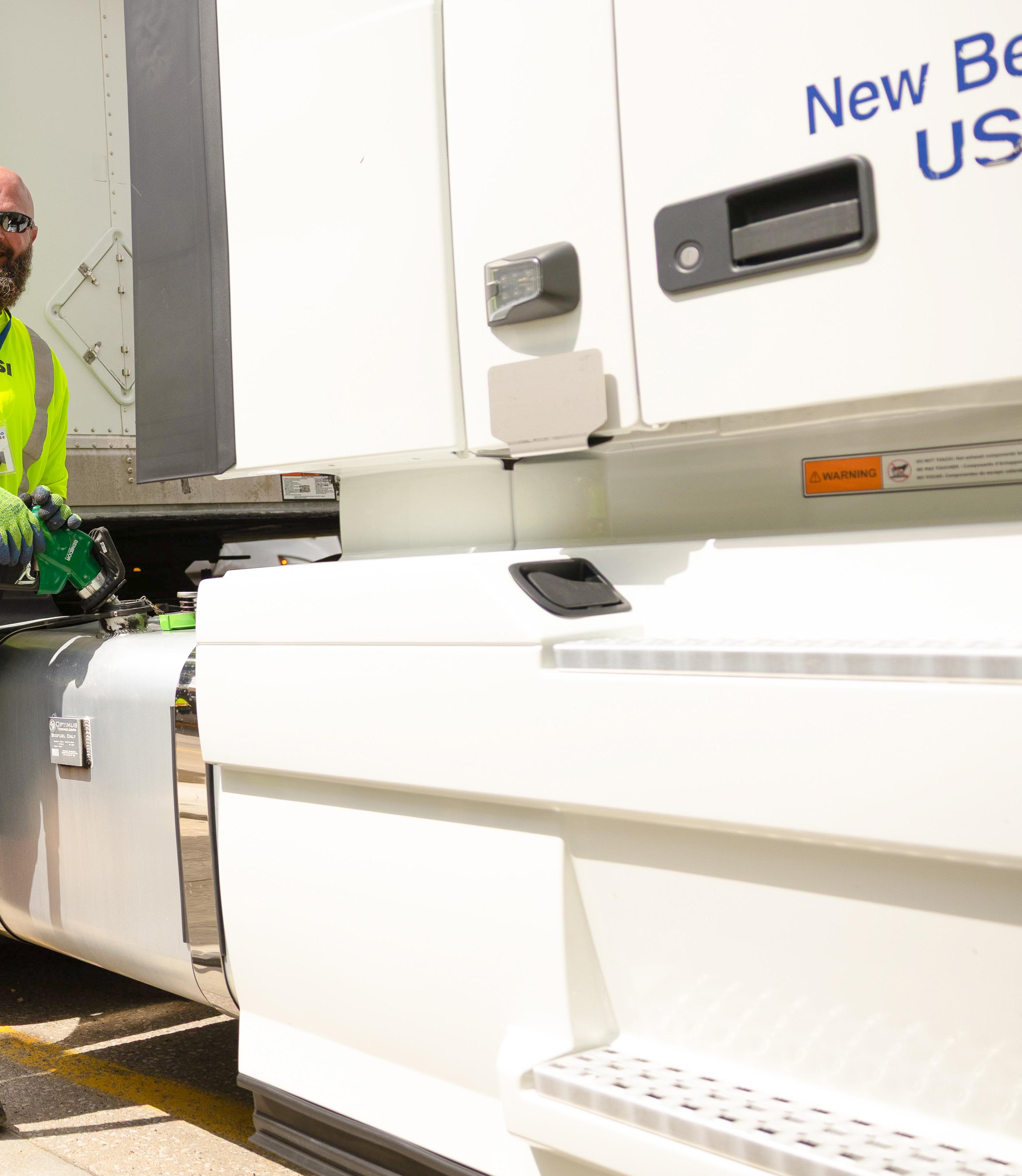
“ Biodiesel is critical to Iowa’s farm economy. It adds real value to every bushel of soybeans we grow — up to 13 percent — supporting local jobs, driving demand and giving us an economic edge.”
Dave Walton, ISA and Iowa Biodiesel Board board member
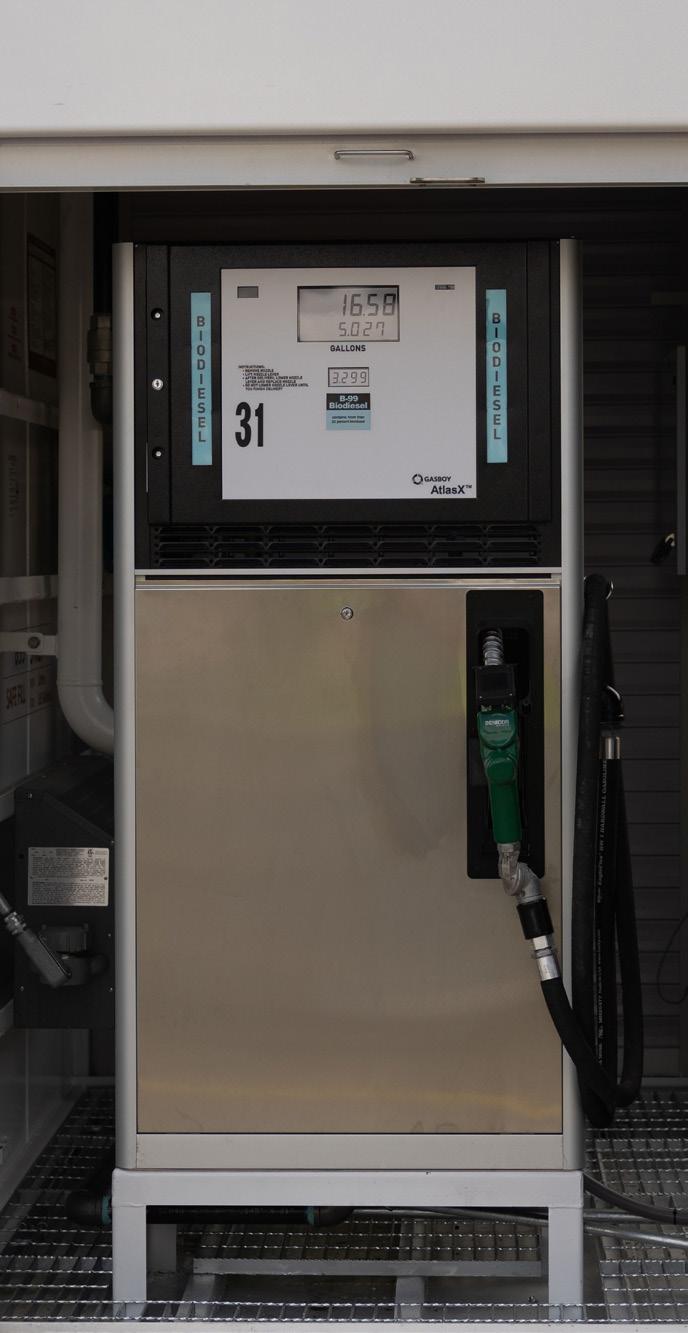

FUELING PROGRESS


The ribbon-cutting event marked progress in the biofuels space.
“This ribbon cutting isn’t just for a new pump — it’s a milestone worth celebrating for what it represents: real, on-the-ground progress in America’s transition to cleaner fuels,” says Dave Walton, a farmer and member of both Iowa Biodiesel Board and Iowa Soybean Association’s Board of Directors. The Iowa Soybean Association and Iowa Biodiesel Board contributed $25,000 in checkoff funding to this project.
The collaboration speaks to the partnerships that are helpful in increasing the demand for biodiesel, thereby increasing the demand for Iowa-grown soybeans.
“Biodiesel is critical to Iowa’s farm economy. It adds real value to every bushel of soybeans we grow — up to 13 percent — supporting local jobs, driving
demand, and giving us an economic edge,” Walton says.
In 2024, Iowa’s then10 operating biodiesel plants produced an estimated 350 million gallons, making it the top biodiesel-producing state. A study by Decision Innovation Solutions shows contributions to all sectors of the state’s economy, including:
$123 million in labor income in Iowa, $520 million in value added and $2.2 billion in output (total sales).
Blends of 20% biodiesel (B20) and higher more than doubled in Iowa’s on-road diesel sales last year, growing to 35% in 2024, according to Walton.
AVAILABILITY
Situated just five minutes away from PepsiCo’s Urbandale plant, the Pilot Travel Center location is ideal for drivers like King and others who aspire to use cleaner fuel options like B99.
“This station is a major win for sustainable energy, helping to make low carbon solutions more accessible,” says Sarah Towles, senior director of government affairs for PepsiCo.
PepsiCo’s semis are equipped with Optimus Technologies’ Vector System which enables heavy-duty diesel engines to operate on 100% biodiesel (B100), resulting in a substantial decrease in CO2 emissions by 85-95%, according to Karl Thomas, an account executive for Optimus Technologies, based in Pittsburgh. Since 2018, Optimus Technologies has equipped more than 1,200 new and existing trucks with the Vector System, allowing for greater use of lower carbon fuels, like biodiesel.
B99 ON SITE
Benecor made the B99 delivery system possible through the Pilot Travel Center, situated between Douglas Avenue and
Dave Walton, ISA and Iowa Biodiesel Board board member
Sarah Towles, PepsiCo senior director of government affairs
On-site blending makes B99 available.

Interstate 35 near Des Moines. The Benecor station delivers a fully insulated and heated turnkey biodiesel storage and dispensing system for efficient, all-weather operation. The system, engineered in Michigan, enables on-site blending of biodiesel and diesel, offering a cost-effective way to meet high biofuel blend rates without needing additional underground infrastructure.
Benecor owner Brendan Foster says demand for the system his company manufactures demonstrates the demand for higher blends of biodiesel.
“We’re talking to other folks out there who are also asking how they can get the higher biofuel rates,” Foster says. “Onsite blending means we’re able to provide a fairly inexpensive approach for the Pilots of the world to take advantage of available credits and offer now another outlet for biodiesel.”
Contact Bethany Baratta at bbaratta@iasoybeans.com
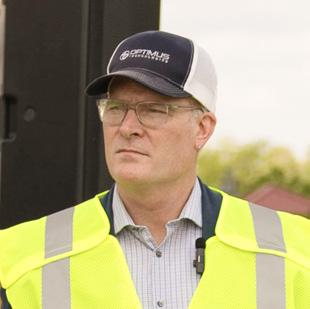


Strengthen soil quality by feeding it the power of the sea. Our cold-processed seafood hydrolysate liquid fertilizer builds soil health and, when applied post-harvest, manages residue to ensure future nutrient availability.

Brendan Foster, Benecor owner
Karl Thomas, Optimus Technologies account executive
Biodiesel advocates joined for a ceremonial ribbon cutting.
Shaping THE FUTURE of Seed
Planning for tomorrow’s farming challenges

JOCLYN KUBOUSHEK
As planting dates move earlier and the growing season stretches longer, soybean breeding is shifting, too. Researchers are working to develop varieties that can better handle drought, stand up to disease and nematodes, and take advantage of longer maturities that often come with higher yield potential.
Continued on Pg. 30
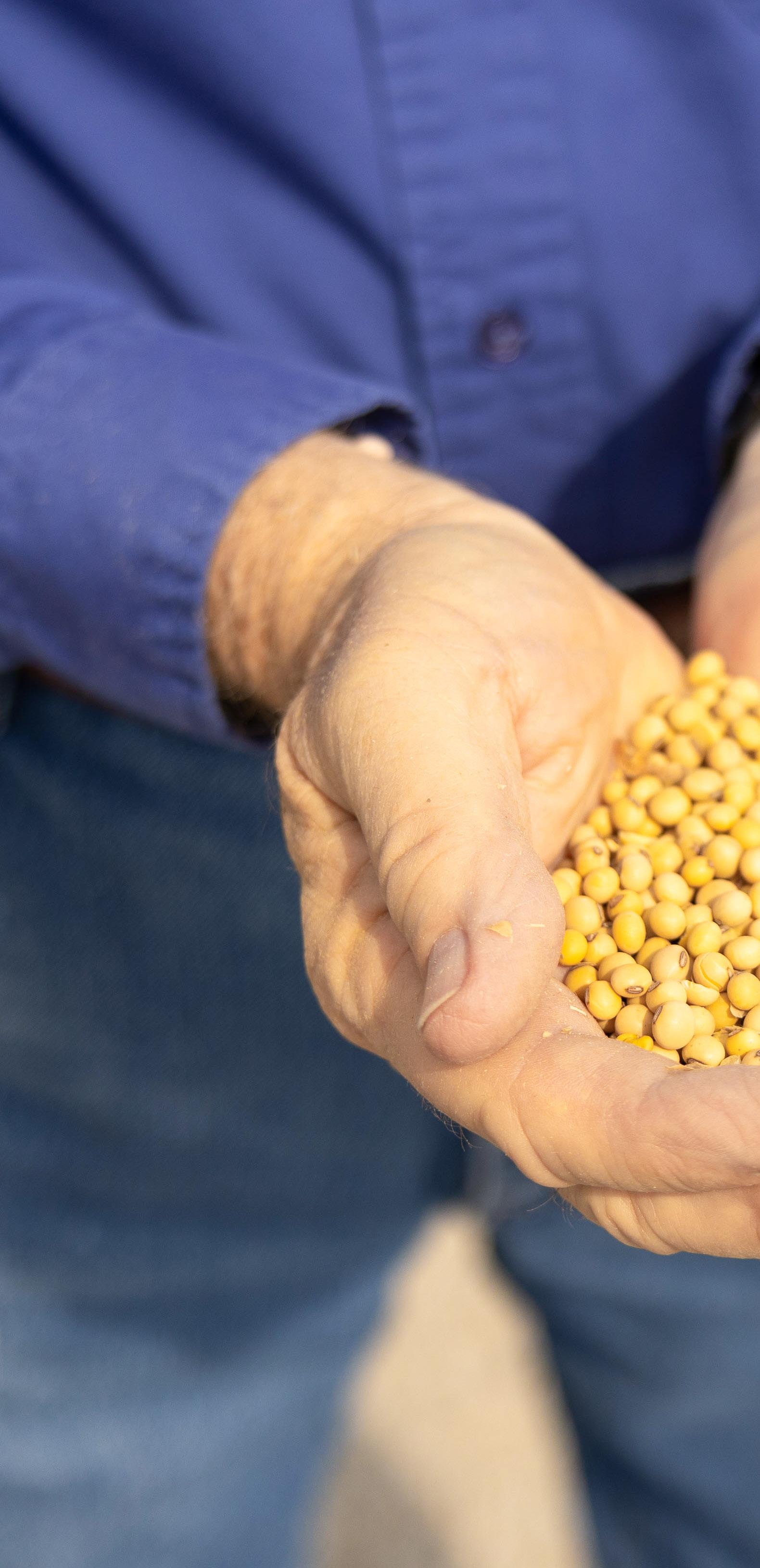
STORY BY
PHOTOGRAPHY BY KRISS NELSON
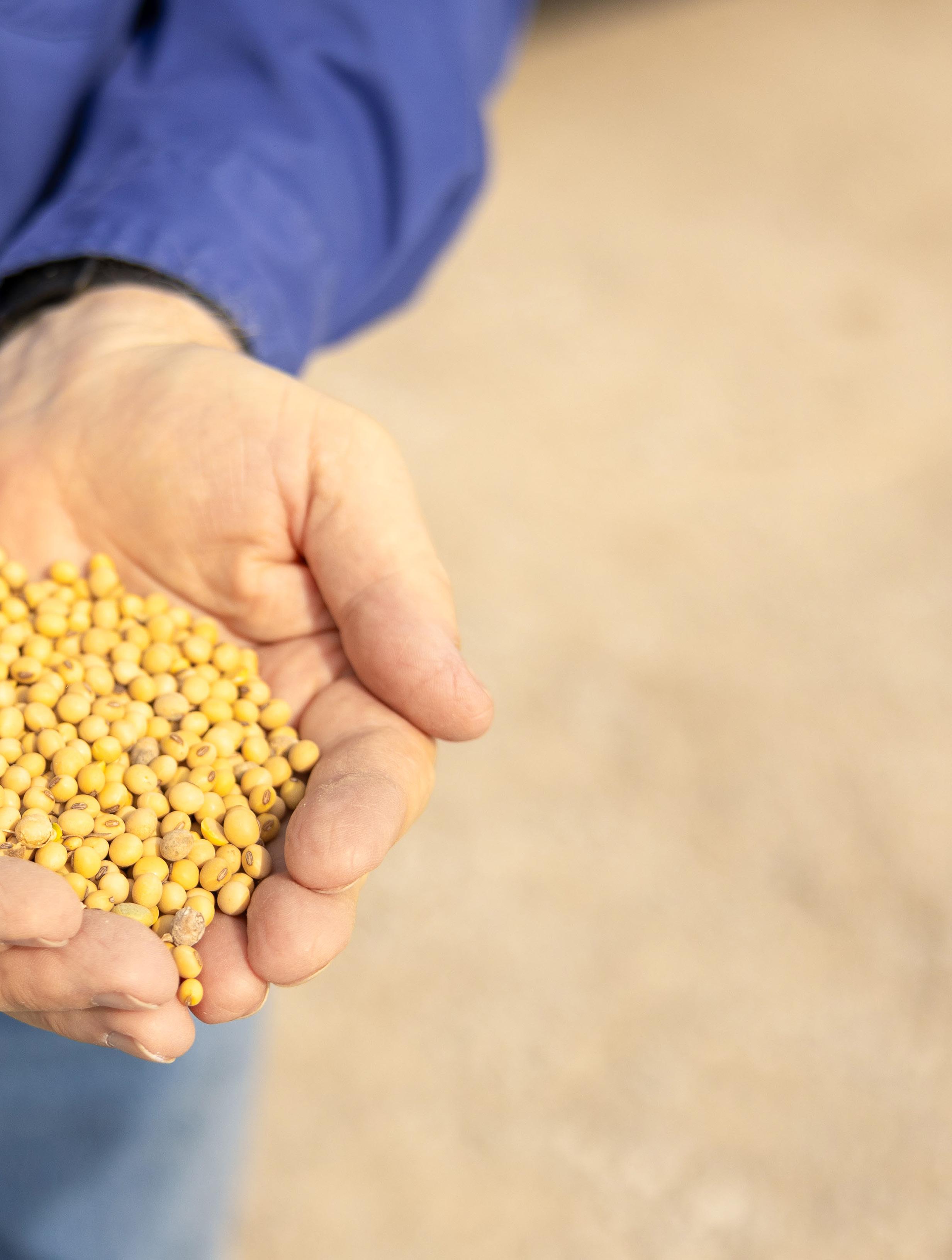
Farmers’ checkoff contributions are being used to help fund research in disease tolerance and increasing yield potential through breeding, grain yield potential, disease susceptibility from planting longer maturity varieties earlier, and evaluating new soybean cyst nematode (SCN)-resistant varieties.”
Mark Licht, ISU assistant professor and extension cropping systems specialist

Mark Licht, ISU
assistant professor and Extension cropping systems specialist
Research drives development
The development of a new soybean variety involves multiple steps, starting with thorough research conducted within universities and seed companies.
At Iowa State University (ISU), soybean checkoff funding is helping researchers examine ways to enhance future soybean varieties.
“Checkoff dollars are woven into the university trials and research,”

Expanding breeding scope
Stine Seed Company focuses its research efforts on extending the utility of its conventional breeding program.
“After 60 years of breeding efforts, our conventional breeding program remains a powerhouse,” says David Thompson, national marketing and sales director for Stine Seed Company.
“Not because it’s conventional, but because it’s our longest-running program and consistently delivers our highest-yielding material.”
He often compares Stine Seed Company’s breeding program to a steam engine train.
“Once it builds momentum, you don’t want to stop it,” he says. “That
momentum powers our pipeline and enables us to keep delivering better genetics year after year.”
Looking toward the future, Thompson believes Stine Seed Company will continue to build steam, focusing research on extending the utility of their products.
“With the trend toward earlier planting dates, top priorities will require traits like cold tolerance, stronger emergence and overall hardiness,” he says.
Improvements in defensive traits against insects and diseases will also continue, helping farmers battle long-standing challenges like SCN and iron deficiency chlorosis.
“Although seed treatments are showing potential in these areas, we need new tools to help growers with that battle,” Thompson says.
Although market demand fluctuates, Stine Seed Company prioritizes the development of better oil and protein varieties.
says Mark Licht, ISU assistant professor and Extension cropping systems specialist. “Farmers’ checkoff contributions are being used to help fund research in disease tolerance and increasing yield potential through breeding, grain yield potential, disease susceptibility from planting longer maturity varieties earlier, and evaluating new soybean cyst nematode (SCN)-resistant varieties.”
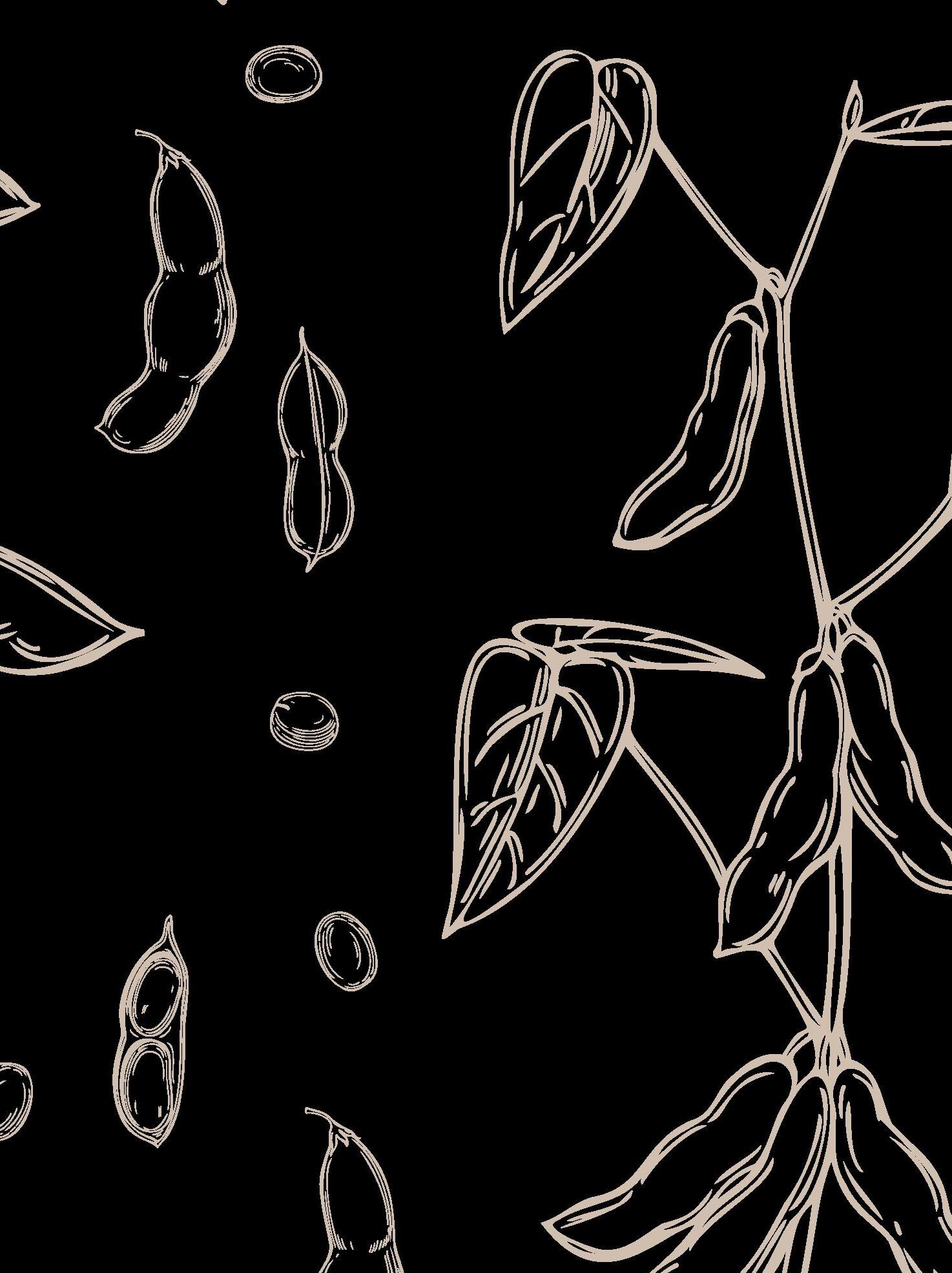
“When bringing those higher oil and protein products to market, our goal is to enhance those traits without sacrificing yield, oil or protein content,” says Thompson.
Years-long process
While tools and traits have changed, the fundamentals of running a successful breeding program have not, Thompson says. “It still comes down to three things: speed, efficiency and volume,” he says.
Soybean varieties take years to develop through research, testing and selection. On average, it takes about six years to move from an initial cross to a variety that’s ready to go into a farmer’s seed bag.
Thompson says it starts with 1.2 million soybean research plots each year, allowing Stine Seed Company to generate and evaluate countless of combinations to select the bestperforming varieties.
“The highest-performing genetic material that comes out of our breeding programs is at the core of everything we do,” he says. “We apply that elite material across all of our efforts in soybean breeding.”
David Thompson, Stine Seed Company national marketing and sales director

Greg Tylka, ISU Morrill Professor in the Department of Plant Pathology and Microbiology and ISRC co-director

Farmers benefit from collaboration
BASF’s June 2024 announcement introduced Nemasphere, a new SCNresistant trait. The product, planned for commercial launch in the 2028 growing season, has connections to ISU.
Greg Tylka, Morrill Professor in the Department of Plant Pathology and Microbiology at ISU and co-director
of the Iowa Soybean Research Center, says Nemasphere — the first and only biotechnology trait for SCN — was evaluated at several locations across Iowa beginning in 2015. The research, conducted in collaboration with BASF and ISU, contributed data that was included in a scientific paper published by a BASF researcher in 2023.

Tom Koch, Ph.D., Beck’s computational genomics manager
Looking
ahead
Preparing seed for the future is also about preparing for the unknown.
That’s the approach at Beck’s, where researchers are combining traditional breeding with data-driven product testing and partnerships with outside tech developers to deliver more adaptable, resilient seed.
Tom Koch, Ph.D., computational genomics manager at Beck’s, says the work is twofold.
The team focuses on improving genetics, but that’s only part of the challenge. The tougher question, Koch says, is trying to predict the environment those genetics will face.
“We don’t know what the weather will be like in one, three or five years from now; wet, dry, extreme,” he says. “So we’re working to make sure we have robust products that can perform in an environment we haven’t seen yet.”
To do that, Beck’s is moving beyond yield trials. Koch says they’re layering in climatic and environmental data, examining how soil, weather, and management practices impact crop performance. That’s where plant characterization comes into play.
Last year, the company launched a new group focused on product characterization research. The goal is to better understand how hybrids respond to different agronomic practices, such as nitrogen management, population density, and root development, before those products reach farmers.
“In the past, we’d release a new hybrid and then learn with the farmer how to grow it,” Koch says. “Now, we want to bring that seed to the farmer with management advice already in hand.”
That information allows advisors to recommend not just what to plant, but how to manage it for better results.
Partnering with innovators
While Beck’s is building this capacity internally, they’re also staying connected to outside innovation. This includes partnerships with startup companies, universities and USDA research labs that are working on agricultural technologies, from genetics to automation.
“There are a lot of smart people out there doing good work,” Koch says. “We don’t claim to have all the answers. And we’re not trying to build everything ourselves; it’s too risky. But if a tool works within our system, we want to support it.”
That mix of in-house data and outside ideas helps Beck’s prepare for what Koch calls “a known plan in an unknown environment.”
“At the end of the day, we’re trying to help farmers succeed no matter what the year throws at them.”
Contact Kriss Nelson at knelson@iasoybeans.com
Building
